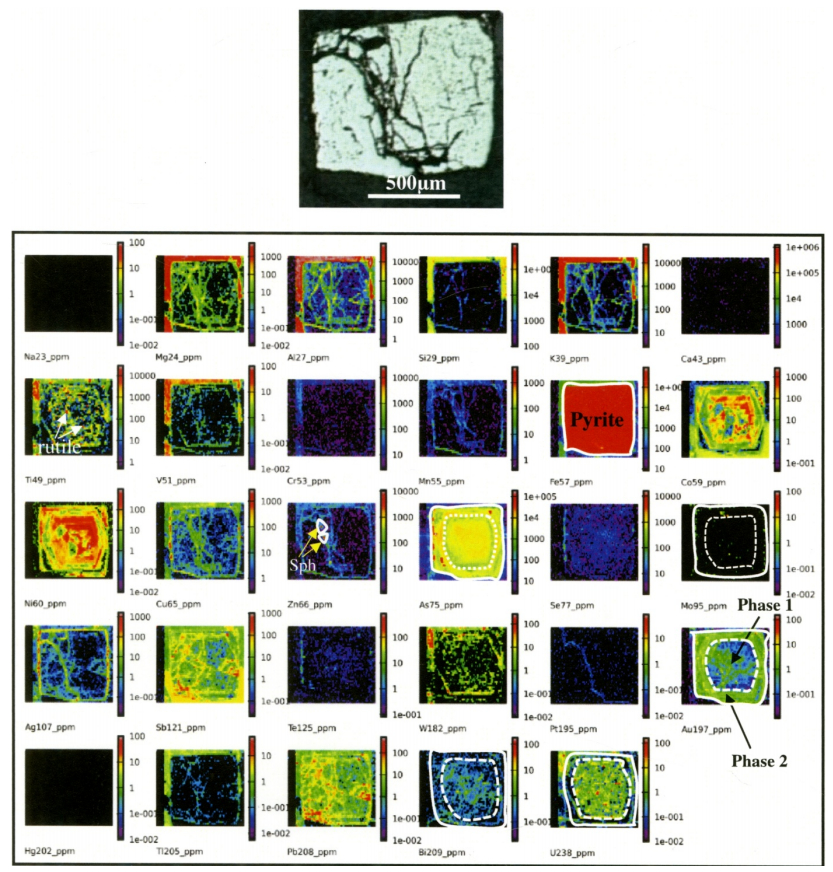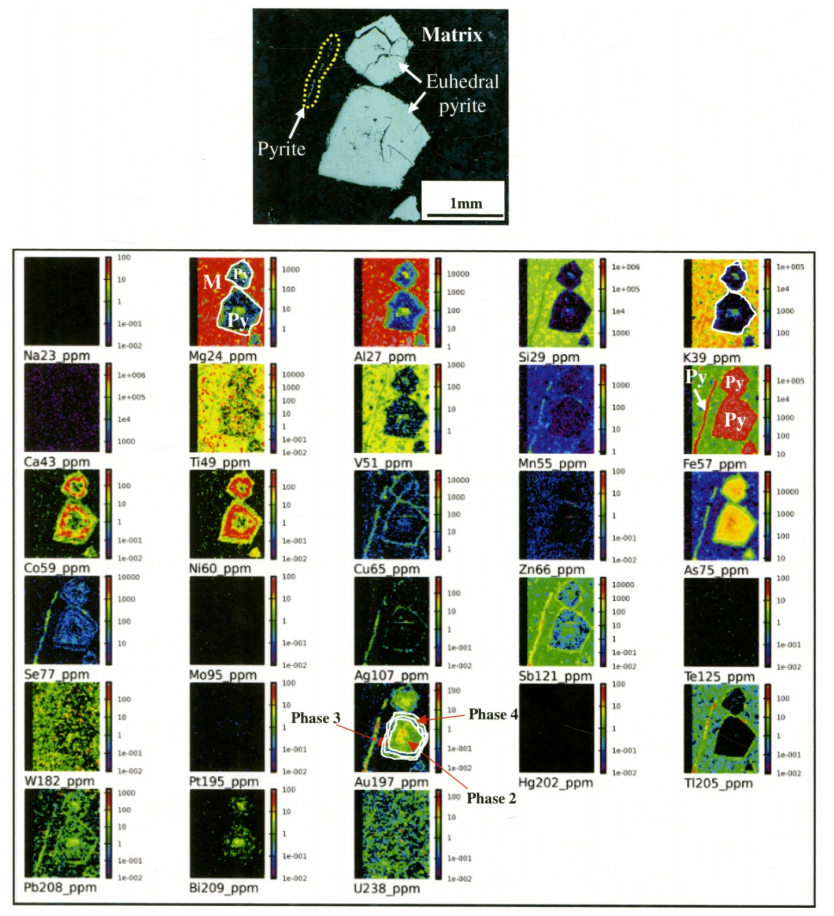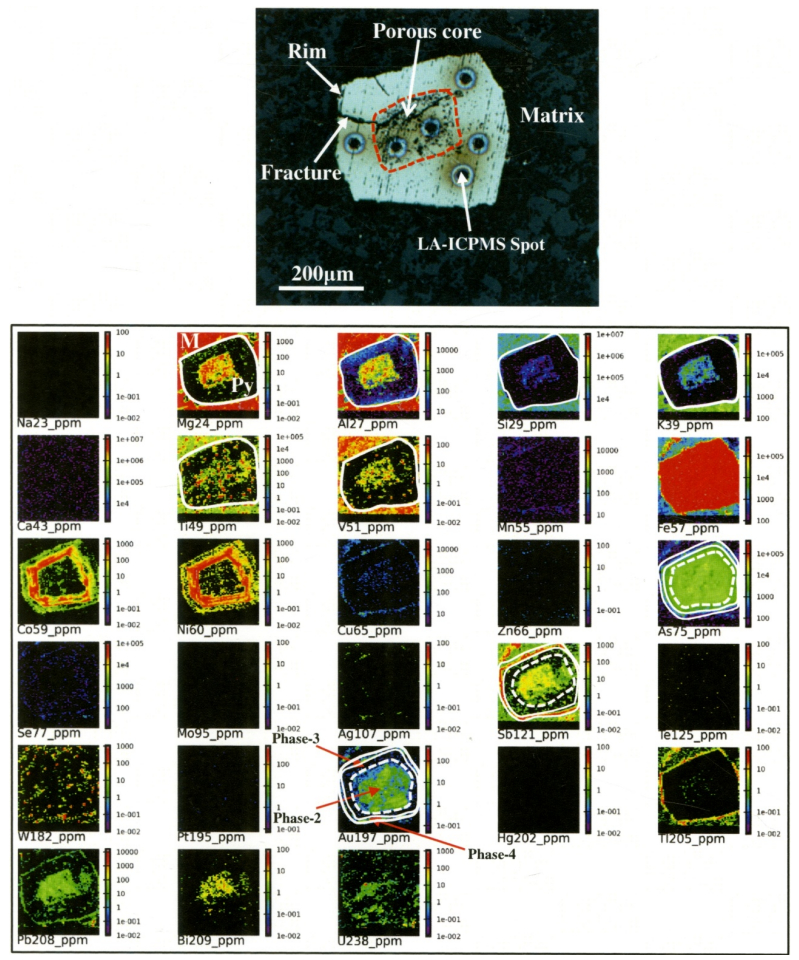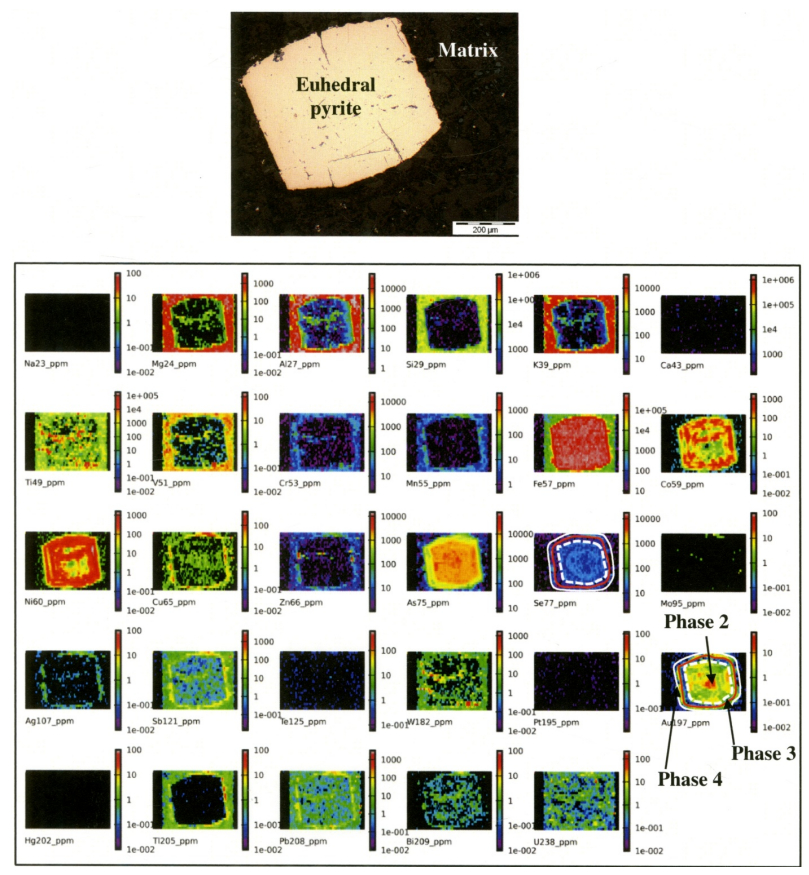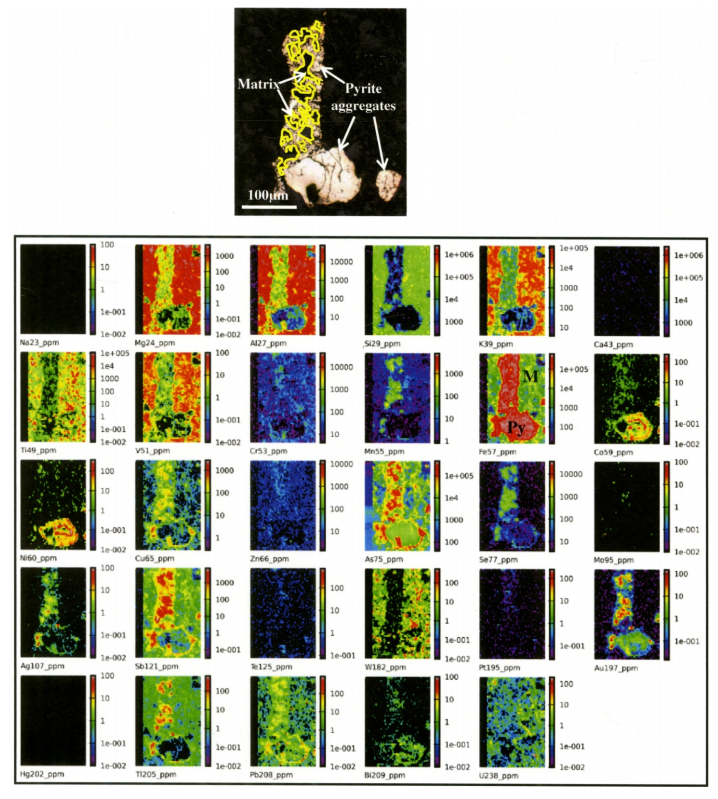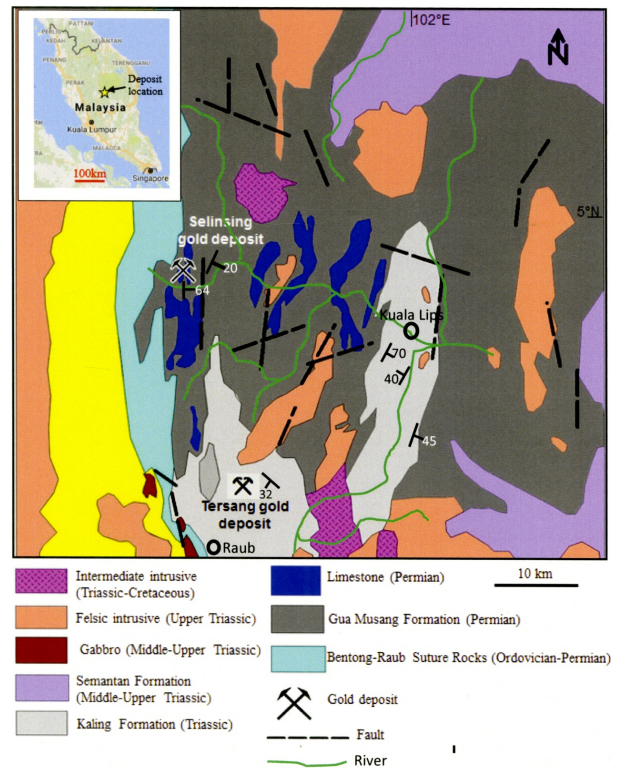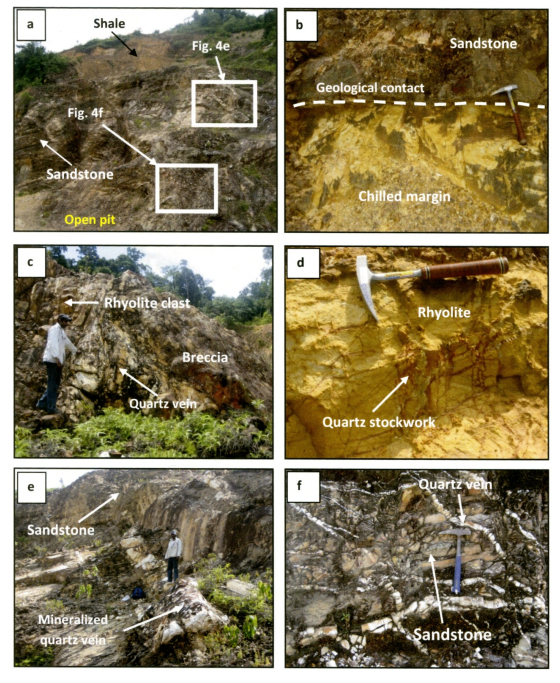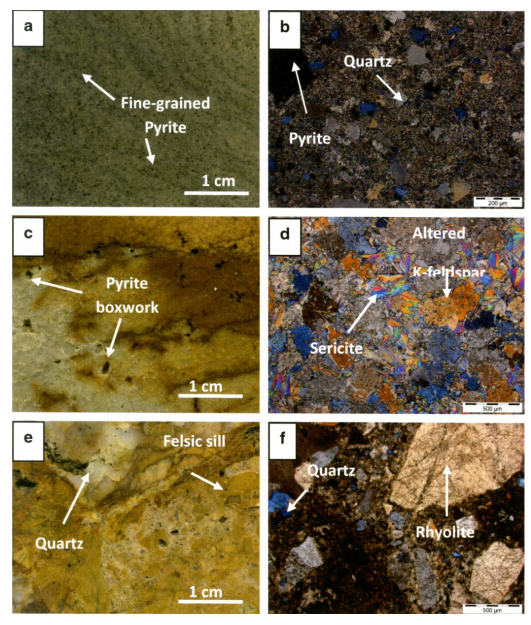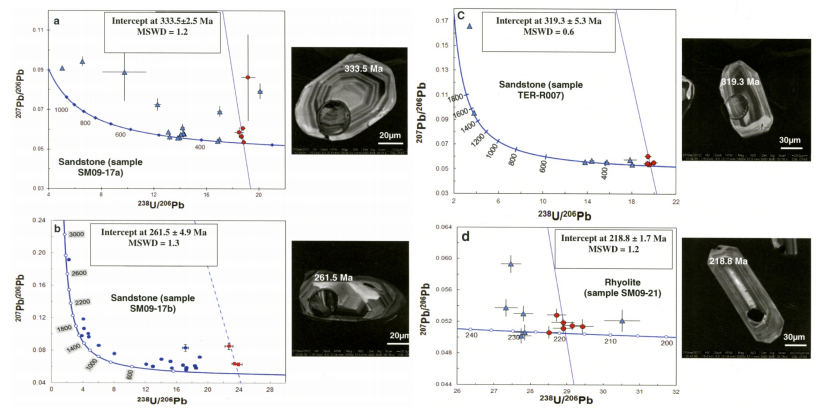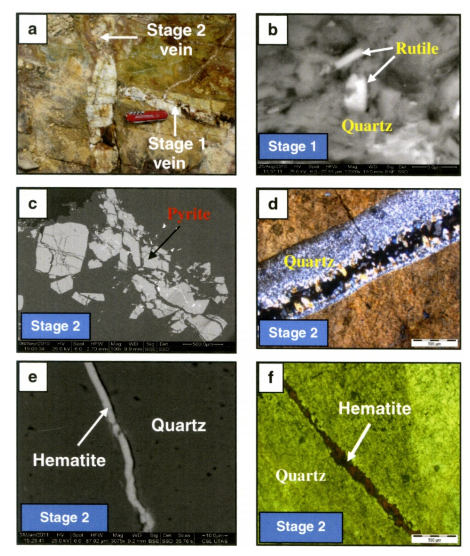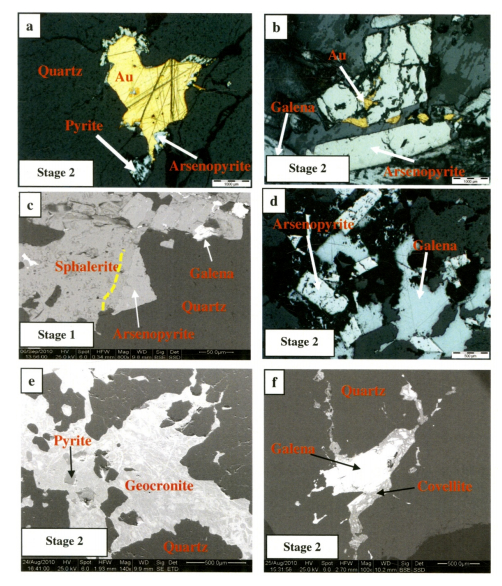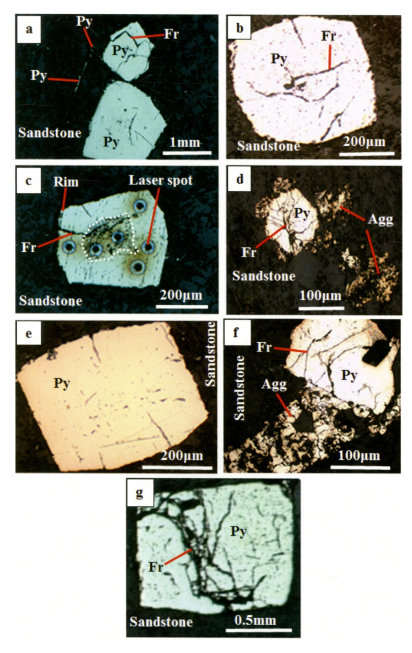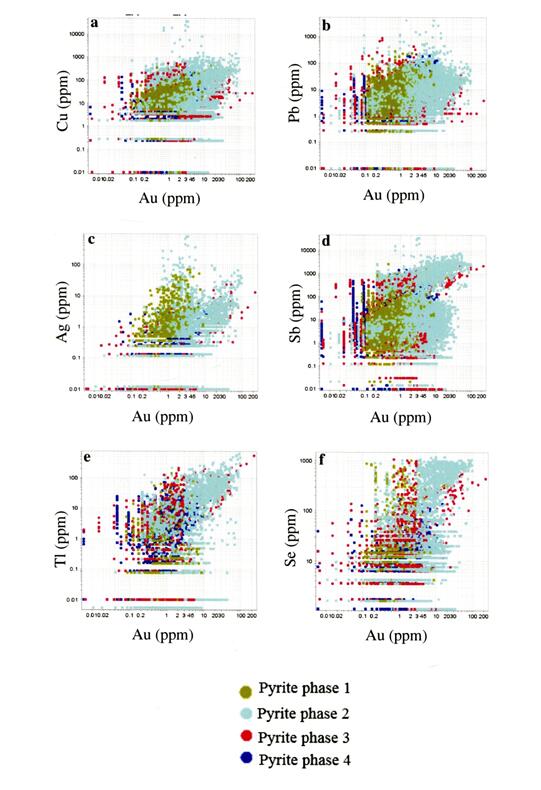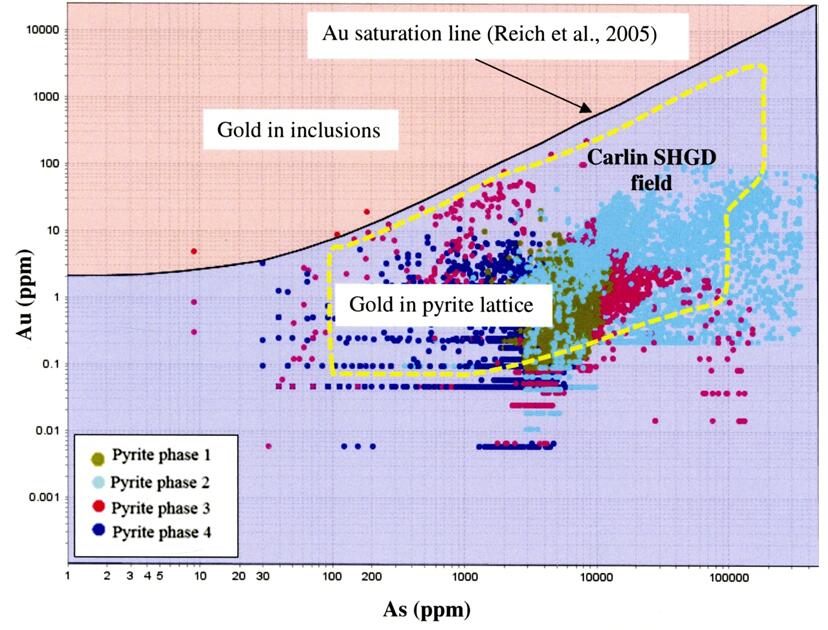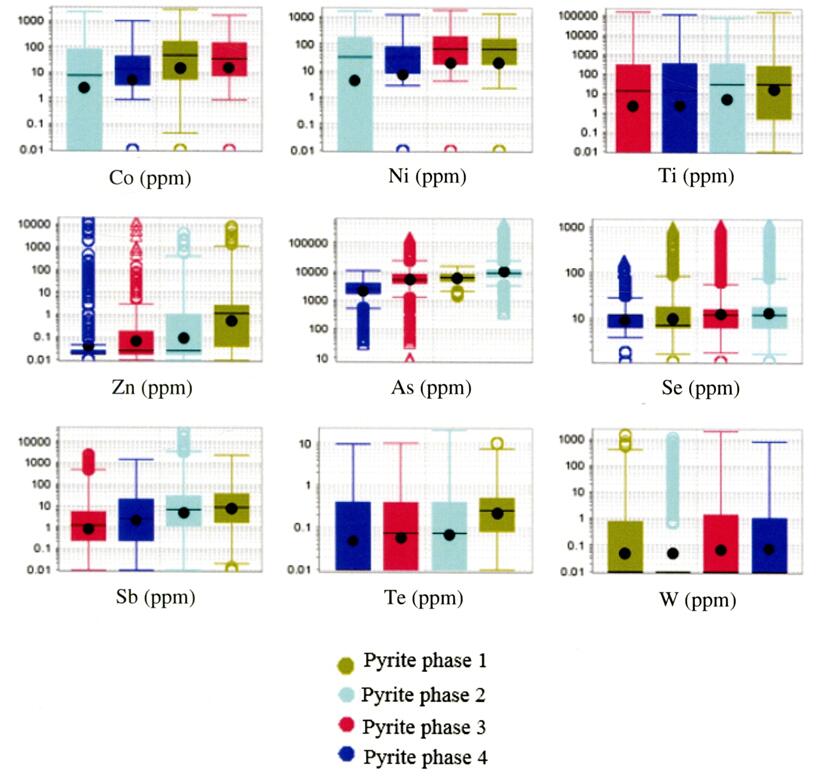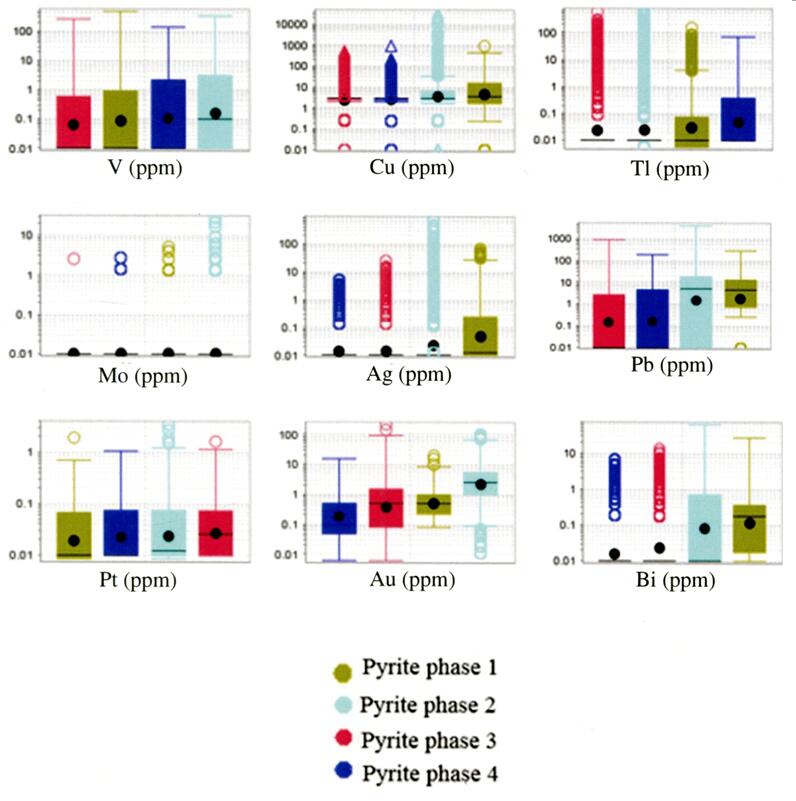1. Introduction
The Tersang gold deposit is located approximately 20 km north of the town of Raub along the eastern side of the Bentong-Raub Suture Zone. Other gold deposits, including Ulu Sokor, Pulai, Chenua, Buffalo Reef, Penjom, Selinsing, and Raub, are also situated in the east of the Bentong-Raub Suture Zone (Figure 1). In 1937, a quantity of 53200 cubic meters of alluvium was mined and about 600 oz of gold were recovered at the mine-site [1]. It is also reported that gold-bearing quartz veins were found in quartz-muscovite rocks in northern Tersang [1]. Peninsular Gold Limited, the current owner of the Tersang gold mine, estimates that the deposit hosts an inferred and indicated resource of 120,000 ounces of gold at 0.71 grams per tonne in the JORC category. It is interpreted that the Carboniferous host rocks of the Tersang gold deposit lie within the Raub Group [2]. The purpose of this study is to constrain depositional ages of host rocks, determine major and trace element composition of the host rocks, document trace element distribution between gold-poor and gold-rich pyrite phase and suggest implications for gold exploration.
2. Geological Setting
Peninsular Malaysia is comprised of three main tectonic terranes/blocks that strike north-south in the Peninsula [2,3,4,5,6]. Yeap [7] defines these terranes as the Western Belt, Central Belt and Eastern Belt after Scrivenor [8] (Figure 1). In recent years, the view that the Malay Peninsula is part of the Southeast Asia continental block which comprises the Sibumasu (Siam, Burma, Malaysia, and Sumatra) Terrane in the west and the Sukhothai Arc (East Malaya Block) in the east has been reiterated [9].
The Western Belt lies within the Sibumasu Terrane. This belt is characterised by Early Palaeozoic continental margin sequences, Late Palaeozoic platform carbonates, Triassic platform carbonates, deep basinal clastic sequences, and Jurassic-Cretaceous continental deposits (Figure 1). The Western Tin Belt is associated with the Main Range granitoid province which is a large plutonic belt that extends to the southern Peninsular Thailand and central Thailand [7]. The Central Gold Belt is located in the east of the Bentong-Raub Suture Zone and comprises Permo-Triassic metamorphic rocks, and deep to shallow marine sedimentary rocks [10,11]. The Central Belt also contains limestone with intermediate to felsic volcanic and volcaniclastic rocks (Carboniferous-Triassic in age), which were deposited in a fore-arc portion of the Paleo-arc basin [1,12,13,14].
The Eastern Belt is part of the East Malaya block and characterised by a poly-deformed Late Palaeozoic sequence, overlain unconformably by Late Permian continental conglomerate and Jurassic-Cretaceous continental deposits. Granitoids in this belt cover a compositional range from biotite granite to hornblende-biotite granite/granodiorite and diorite-gabbro [15]. In addition, this belt includes a suite of shoshonitic trachyte in the Segamat area (Johor) which has been dated by K/Ar dating and returned an age of 62 Ma [16]. The Eastern Belt plutons consist of biotite or hornblende-biotite-bearing Ⅰ-type granitoids with Triassic Rb-Sr ages. Ⅰ-type granitoids are typical of modern day Andean-type active margins where oceanic plates are subducted under continental margins or island arcs producing andesite volcanoes.
The Bentong-Raub Suture Zone is a significant NW-SE trending fault system. The suture is suggested to be genetically related to the gold mineralisation in the mining district of the Central Gold Belt. The Bentong-Raub Suture Zone of the Malay Peninsula represents the main Palaeo-Tethys ocean basin and forms the boundary between the Sibumasu Terrane in the west and the Sukhothai Arc in the east [2]. The suture extends up to 20 km in width containing oceanic radiolarian cherts ranging in age from Devonian to Upper Permian [4]. Within this suture, there is mélange composed of clasts of ribbon-bedded chert, limestone, sandstone, conglomerate, turbidites, volcanic and volcaniclastic rocks. Additionally, bodies of serpentinite interpreted to be mafic/ultramafic rocks and oceanic peridotites are documented [17]. Chert and limestone clasts in the mélange were dated by radiolarians, conodonts and foraminifera and gave an age of Carboniferous and Permian [17]. Ages of metamorphism were determined from Schist and phyllite samples as being Ordovician, Silurian and Devonian. Consistently, the radiolarian cherts returned another wider age range from Devonian to Upper Permian [3].
3. Methods of Study
The methods of study described here include field work at the gold deposit area as well as laboratory work that were carried out at the ARC (Australian Research Council) Centre of Excellence in Ore Deposits (CODES), University of Tasmania, Australia. Field mapping was carried out recording lithology and structures at a scale of 1:2000. A GPS (global positioning system) was used to provide positions accurate to 3–10 m depending on the signal reception quality. In this study, coordinate systems are in UTM (Universal Transverse Mercator), zone 47, northern hemisphere (Map datum-WGS 84). If UTM and RSO (Rectified Skew Orthomorphic) systems were used, the coordinates were shown as northing and easting, typically in meters. At some locations, standard mine grids were converted to RSO or UTM for accurate locations of the mapped area. Thirty eight sedimentary rock and quartz vein samples were collected. List of samples is presented in Table 1.
Table 1. List of samples collected in the field from the Tersang, mesothermal gold deposit, Malaysia.
| Location |
Sample ID |
X_UTM |
Y_UTM |
Z |
Field Description |
Visible mineral-alteration |
Visible structure |
| Main pit |
TER-R001 |
812863 |
440915 |
148 |
Sandstone |
Pyrite boxwork and FeO |
Bedding and jointing |
| Main pit |
TER-R002 |
812863 |
440917 |
154 |
Quartz vein |
|
quartz vein intersection |
| Main pit |
TER-R003 |
812863 |
440918 |
157 |
Quartz vein |
Propylitic alteration |
Bedding and jointing |
| Main pit |
TER-R004 |
812863 |
440921 |
158 |
Quartz vein |
|
Vein intersection |
| Main pit |
TER-R005 |
812863 |
440926 |
161 |
Quartz vein |
Disseminated Pyrite, FeO |
quartz vein intersection |
| Main pit |
TER-R006 |
812851 |
440918 |
164 |
Quartz vein |
Disseminated Pyrite |
Vein cuts bedding |
| Main pit |
TER-R007 |
812851 |
440918 |
163 |
Sandstone |
Disseminated Pyrite |
Bedding |
| Main pit |
TER-R008 |
812719 |
440890 |
142 |
Quartz vein |
|
|
| Main pit |
TER-R009 |
812719 |
440890 |
142 |
Quartz vein |
Propylitic alteration |
|
| Main pit |
TER-R010 |
812719 |
440890 |
142 |
Quartz vein |
|
|
| Main pit |
TER-R011 |
812851 |
440920 |
151 |
Quartz vein |
Disseminated Pyrite |
Vein parallel to bedding |
| West of quarry |
TER-R012 |
812846 |
440914 |
169 |
Quartz vein |
Disseminated Pyrite |
|
| West of quarry |
TER-R013 |
812846 |
440911 |
171 |
Quartz vein |
Disseminated Pyrite |
Vein intersection |
| West of quarry |
TER-R014 |
812861 |
440908 |
168 |
Quartz vein |
Disseminated Pyrite |
|
| Main pit |
TER-R015 |
812858 |
440906 |
160 |
Quartz vein |
Disseminated Pyrite |
Vein intersection |
| Main pit |
TER-R016 |
812836 |
440912 |
158 |
Quartz vein |
Disseminated Pyrite |
Quartz lens |
| Main pit |
TER-R017 |
812791 |
440917 |
157 |
Quartz vein |
|
Vein cuts across bedding |
| Main pit |
TER-R018 |
812808 |
440883 |
158 |
Quartz vein |
|
Vein parallel to bedding |
| Main pit |
TER-R019 |
812808 |
440883 |
158 |
Quartz vein |
|
Vein cuts across bedding |
| Main pit |
TER-R020 |
812865 |
440891 |
170 |
Quartz vein |
|
Vein intersection |
| Main pit |
TER-R021 |
812871 |
440895 |
159 |
Quartz vein |
Sulfide |
|
| East of quarry |
TER-R022 |
812889 |
440918 |
171 |
Quartz vein |
Sulfide |
Fault F1 |
| East of quarry |
TER-R023 |
812885 |
440927 |
178 |
Quartz vein |
Disseminated Pyrite |
Fault F1 |
| East of quarry |
TER-R024 |
812884 |
440931 |
179 |
Quartz vein |
Propylitic alteration, sulfide |
Fault F1 |
| East of quarry |
TER-R025 |
812881 |
440930 |
180 |
Quartz vein |
Disseminated Pyrite |
Vein parallel to Fault F1 |
| East of quarry |
TER-R026 |
812906 |
440994 |
175 |
Quartz vein |
Disseminated Pyrite |
|
| East of quarry |
TER-R027 |
812894 |
440898 |
167 |
Quartz vein |
Disseminated Pyrite |
|
| Northwest |
TER-R028 |
812630 |
441094 |
165 |
Rhyolite |
|
|
| Northwest |
TER-R029 |
812689 |
441071 |
174 |
Quartz vein |
Disseminated Pyrite |
Vein cuts across bedding |
| Northwest |
TER-R030 |
812753 |
441009 |
182 |
Quartz vein |
Disseminated Pyrite |
Vein cuts across bedding |
| North |
TER-R031 |
812723 |
441204 |
210 |
Quartz vein |
|
|
| North |
TER-R032 |
812782 |
441210 |
217 |
Fault breccia |
Sulfide |
|
| Northeast |
TER-R033 |
812858 |
441160 |
226 |
Felsite |
|
|
| East |
TER-R034 |
812826 |
441070 |
221 |
Quartz vein |
Sulfide |
|
| East |
TER-R035 |
812826 |
441120 |
226 |
Quartz vein |
Sulfide |
|
| Southeast |
TER-R036 |
812910 |
440853 |
172 |
Quartz vein |
|
|
| Southeast |
TER-R037 |
812937 |
440938 |
204 |
Quartz vein |
|
Vein parallel to fault plan |
| Southeast |
TER-R038 |
812937 |
440938 |
204 |
Quartz vein |
|
Vein parallel to fault plan |
| Southeast |
TER-R039 |
812928 |
440904 |
186 |
Quartz vein |
Sulfide |
|
| Southeast |
TER-R040 |
812920 |
440880 |
177 |
Quartz vein |
Sulfide |
|
| North |
SM09-17A-B |
812725 |
441170 |
211 |
Sandstone |
|
|
| North |
SM09-21 |
812783 |
441212 |
212 |
Rhyolite |
|
|
The analytical techniques that were used in the study include: U-Pb zircon dating [18], Back-scattered imaging (BSE) and mineral spectra (EDS) using scanning electron microscope, Trace element determination in pyrite and mapping of pyrite grains by LA ICP-MS [19,20]. In addition, Cathodoluminescence (CL) imaging of zircon grains was carried out. These techniques are described below.
3.1. U-Pb zircon dating
Approximately 200 g of rock was crushed and milled in a Cr-steel ring mill to a grain size of less than 400 µm. Non-magnetic heavy minerals were then separated using a gold pan and a Fe-B-Nd hand magnet. The zircons were hand-picked from the heavy mineral concentrate under the microscope in cross-polarised transmitted light. The standard procedure for the LA ICP-MS zircon dating is performed on an Agilent 7500cs quadrupole ICPMS with a 193 nm coherent Ar-F gas laser and the resonetics M50 ablation cell.
The downhole fractionation, instrument drift and mass bias correction factors for Pb/U ratios on zircons were calculated using two analyses on the primary (91500 standard of Wiendenbeck [21]) and one analysis on each of the secondary standard zircons [22,23] analysed at the beginning of the session and every 12 unknown zircons (roughly every 1/2 hour) using the same spot size and conditions as used on the samples. Additional secondary standards (The Mud Tank Zircon of Black and Gulson [24] were also analysed. The correction factor for the 207Pb/206Pb ratio was calculated using three large spots of NIST610 analysed at the beginning and the end of the day and corrected using the values recommended by Baker [25]. Each analysis on the zircons began with a 30 second blank gas measurement followed by a further 30 seconds of analysis time when the laser was switched on. Zircons were sampled on 32 micron spots using the laser at 5 Hz and a density of approximately 1.5 J/cm2. A flow of He carrier gas at a rate of 0.6 liters/minute carried particles ablated by the laser out of the chamber to be mixed with Ar gas and carried to the plasma torch.
Isotopes measured include 49Ti, 96Zr, 146Nd, 178Hf, 202Hg, 204Pb, 206Pb, 207Pb, 208Pb, 232Th and 238U with each element being measured sequentially every 0.16 s with longer counting time on the Pb isotopes compared to the other elements. The data reduction used was based on the method outlined in detail in Meffre [26] similar to that outlined in Black [25] and Paton [27]. Element abundances on zircons were calculated using the method outlined by Kosler [18] using Zr as the internal standard element, assuming stoichiometric proportions and using the 91500 to standard correct for mass bias.
3.2. LA-ICP-MS analysis technique
Trace element analysis and imaging of pyrite were undertaken using the LA-ICP-MS facility at CODES, University of Tasmania. Analyses were done using a Newwave UP213 laser ablation microprobe coupled with an Agilent 7500 or 7700 ICP-MS. Samples were ablated in He and mixed with Ar before reaching the ICP-MS. Calibration was carried out with the in-house standard (STDGL2b2), which is a lithium borate fused glass disk, with known concentrations of trace elements [19]. The standard was analysed at regular intervals during analysis to correct for drift and mass bias. For standard set-up, the Fe concentration was tabulated at 465000 ppm (46.5 %) for pyrite. To minimize surface contamination, sulphides were pre-ablated with laser pulses. For pyrite imaging, the laser was rastered across the sample in a series of parallel lines. The spot size of the laser was 22µm during pyrite mapping and there was no space between the lines. All the data was binned to give the pixels in the maps.
Each line was pre-ablated before analysis. The backgrounds were recorded before each image and subtracted from each analysis line [18]. A total of twenty-nine elements were analysed by LA-ICP-MS from pyrites including: Na, Mg, Al, Si, K, Ca, Ti, V, Cr, Mn, Fe, Co, Ni, Cu, Zn, As, Se, Mo, Ag, Sb, Te, W, Pt, Au, Hg, Tl, Pb, Bi and U. The element maps were processed as follows: First, the trace element maps were converted from count per second into part per millions (ppm) in order to get a robust representation of element concentration for each pyrite type. Secondly, the csv files were imported into ioGAS© which is an advanced geochemical exploratory data analysis software package. Thirdly, pyrite phases were recognized based on element distribution on each pyrite map. In total, four pyrite phases were identified using ioGAS© software in terms of high content in Te, As and low content in Au and As. In ioGAS software, a clustering method was used by uploading all pyrite pixel data in the form of csv data. Furthermore, an attribute map was made on which pyrite boundaries of all analyzed grains were displayed. Each pyrite phase was discriminated digitally and assigned a colour. In addition, each pyrite phase outline or boundary that is shown on LA-ICPMS maps has been drawn by hands (Figures 2–8).
Finally, pyrite phase values were calculated by grouping all the pixels belonging to a given pyrite phase. Other datasets such as minimum, maximum, median, and standard deviation for the pyrite phases 1, 2, 3, and 4 are also documented. Additionally, the Pearson coefficients of correlation among Au and other trace elements for pyrite phases 1, 2, 3, and 4 are presented in Tables 8A–D. Positive correlation implies that both variables tend to move in the same direction: If one variable increases, the other tends to also increase. If one decreases, the other tends to also. Negative correlation means that the variables tend to move in the opposite directions: If one variable increases, the other tends to decrease, and vice-versa. Correlation matrix was calculated for each pyrite phase by looking at the relationship among Au and other trace elements. In this paper, we use a weak correlation for the coefficients that vary from 0.3 to 0.4. A moderate correlation is considered for coefficients ranging from 0.5 to 0.6 and a strong correlation for numbers above or equal to 0.7 [28].
4. Local and Deposit Geology
4.1. Local geology
Haile [29] documented that the Tersang gold deposit lies within a Carboniferous sequence, which comprises shale, quartzite, conglomerate, phyllite belonging to the Raub Formation or Group. These authors correlated the Tersang sedimentary and metamorphic rocks to those of the Raub Group based on lithological features. In addition, these rocks are overlain by Carboniferous to Permian calcareous shale. In the northwest of the Tersang area, tuff sequences overlie the calcareous shale and contain fossils, indicating an age range from Carboniferous to Triassic. In the north (Figure 9), occurrences of felsic igneous rocks may be the extension of the rhyolite that crops out in the open pit. The local geology map (Figure 9) also displays the locality of the Selinsing gold deposit further north. To the west, gabbroic bodies are common and associated with the Bentong-Raub Suture rocks. To the east, intermediate igneous rocks crop out.
4.2. Deposit geology
The Tersang gold deposit is characterised by a belt of gold mineralisation trending NS and comprises 1800 m long rhyolite body mixed up with shale and sandstone (Figure 10). The ore zone is characterised by the presence of sheeted quartz veins and sulphide mineralisation hosted in the sandstone and rhyolite. In the north, the rhyolite occurs associated with siltstone and shale beds and also overprinted quartz stockwork. Tuff sequences crop out in the northwest, underlying the shale strata. In the south of the mineralised corridor, the main lithologies are made up of sandstone, breccia and rhyolite in a highly tectonized area. This zone contains multitude of quartz stockwork veins (Figure 10). The area that was mapped during this study is situated between northing 812600 m and 81300 mN and easting 440800 m and 441300 mE (UTM system) (Figure 10). The area represents the open pit, comprising grey sandstone and breccia, which are interfingered with rhyolite. The white area on the mine-scale map (Figure 10) represents the Kaling Formation shown in grey colour on the district-scale map in Figure 9.
The Tersang northern zone was not considered in this study as it is forested with lack of fresh outcrops. The sandstones are commonly eroded locally in the mining area and the geologic contact between the sandstones and shales (partly metamorphosed to phyllite) is hardly visible. The sandstone crops out in the open pit (the central part) and the southern part of the deposit (Figure 11a), and is grey in colour when less weathered. The sandstone is fine-grained, poorly sorted in contact with the chilled margins in the northwest and northeast parts of the deposit (Figure 11b).
The sandstone contains pyrite grains and veins and its petrography consists of quartz (60 vol. %), K-feldspar (10 vol. %), biotite (20 vol. %), and disseminated pyrite (up to 10 vol. %). A greyish brown, oxidised breccia unit of 40–50 m in length and 20–25 m in width crops out within the rhyolite unit (Figure 11c). The breccia, under the microscope shows rhyolite and sandstone angular fragments (60 vol. %) and matrix (40 vol. %). The fragments have a size ranging from 0.3 to 1 cm. Small-scale stockworks of quartz veinlets (up to 200 µm thick) are also present. Oxidised pyrite grains are contained in some rock fragments. The matrix is mainly siliceous and contains iron oxides.
The rhyolite associated with quartz stockwork is exposed over an area of approximately 600 m long and 400 m wide in the central and northern parts of the deposit (Figure 11d). Thin section studies revealed the presence of quartz (70 vol. %), K-feldspar (10 vol. %), muscovite (10 vol. %), and pyrite (up to 10 vol. %). In addition, muscovite occurs in the form of laths and interstitial infillings. Two stages of mineralised quartz veins were delineated: Stage 1 vein trends NNW-SSE (Figure 11e) and stage 2 vein strikes ESE-WNW (Figure 11f). Lithological and mineralogical characteristics of host rock and intrusion are shown in Figure 12. The list of samples and their descriptions is documented in Table 1.
5. U-Pb Zircon Dating
The host sandstone and rhyolite were sampled and analysed for age determination. Results of the U-Pb zircon geochronology are shown in Tables 2–5. The calculation of ages is on 1σ error on each concordia plot. A hand specimen of sandstone (sample SM09-17a) was analysed (Figure 13a). The seven youngest zircons have a mean age of 333.5 ± 2.5 Ma (MSWD = 1.2) and a median value of 333 Ma indicating an Early Carboniferous age (Mississippian). The detrital zircon populations are at ca. 250–400 Ma, ca. 875 Ma and ca.1100 Ma. Th/U values range from 0.07 to 1.56. CL imaging shows that the detrital zircon grains are sub-angular with oscillatory zoning. Results of the U-Pb zircon dating of this sample are presented in Table 2.
Table 2. Results of U-Pb zircon dating of the host sandstone (sample SM09-17a).
|
207 cor 206Pb/238U |
+/-1 ster |
206Pb/238U |
+/-1 RSE |
207Pb/206Pb |
+/-1 RSE |
238U/206Pb |
+/-1 std err |
207Pb/206Pb |
+/-1 std err |
206Pb/238U |
+/-1 ster |
| SM09-17a |
|
|
0.0136 |
1.5% |
0.0479 |
6.3% |
73.42 |
1.10 |
0.0479 |
0.0030 |
87 |
149 |
| SM09-17a |
303 |
3 |
0.0497 |
1.1% |
0.0795 |
4.8% |
20.10 |
0.22 |
0.0795 |
0.0039 |
313 |
96 |
| SM09-17a |
314 |
9 |
0.0521 |
2.8% |
0.0862 |
25.3% |
19.18 |
0.54 |
0.0862 |
0.0218 |
328 |
489 |
| SM09-17a |
331 |
3 |
0.0532 |
1.0% |
0.0606 |
2.1% |
18.79 |
0.18 |
0.0606 |
0.0013 |
334 |
45 |
| SM09-17a |
333 |
3 |
0.0530 |
0.9% |
0.0535 |
3.3% |
18.86 |
0.17 |
0.0535 |
0.0017 |
333 |
74 |
| SM09-17a |
335 |
2 |
0.0535 |
0.7% |
0.0564 |
2.2% |
18.69 |
0.13 |
0.0564 |
0.0013 |
336 |
49 |
| SM09-17a |
335 |
2 |
0.0535 |
0.7% |
0.0566 |
2.2% |
18.68 |
0.13 |
0.0566 |
0.0012 |
336 |
48 |
| SM09-17a |
337 |
7 |
0.0541 |
2.0% |
0.0586 |
4.5% |
18.50 |
0.37 |
0.0586 |
0.0027 |
339 |
99 |
| SM09-17a |
361 |
4 |
0.0588 |
1.1% |
0.0691 |
3.9% |
17.01 |
0.19 |
0.0691 |
0.0027 |
368 |
81 |
| SM09-17a |
368 |
3 |
0.0589 |
0.8% |
0.0549 |
2.5% |
16.99 |
0.14 |
0.0549 |
0.0014 |
369 |
56 |
| SM09-17a |
371 |
3 |
0.0593 |
0.7% |
0.0542 |
1.9% |
16.87 |
0.12 |
0.0542 |
0.0010 |
371 |
42 |
| SM09-17a |
434 |
3 |
0.0699 |
0.6% |
0.0577 |
1.9% |
14.31 |
0.09 |
0.0577 |
0.0011 |
435 |
41 |
| SM09-17a |
435 |
4 |
0.0701 |
1.0% |
0.0580 |
3.2% |
14.27 |
0.14 |
0.0580 |
0.0018 |
437 |
69 |
| SM09-17a |
436 |
4 |
0.0704 |
1.1% |
0.0609 |
3.1% |
14.19 |
0.15 |
0.0609 |
0.0019 |
439 |
68 |
| SM09-17a |
442 |
3 |
0.0712 |
0.6% |
0.0575 |
2.0% |
14.05 |
0.09 |
0.0575 |
0.0011 |
443 |
44 |
| SM09-17a |
446 |
2 |
0.0717 |
0.5% |
0.0559 |
1.2% |
13.95 |
0.08 |
0.0559 |
0.0007 |
446 |
26 |
| SM09-17a |
450 |
4 |
0.0723 |
0.8% |
0.0558 |
2.1% |
13.84 |
0.11 |
0.0558 |
0.0012 |
450 |
46 |
| SM09-17a |
471 |
4 |
0.0758 |
0.9% |
0.0563 |
3.3% |
13.20 |
0.12 |
0.0563 |
0.0019 |
471 |
73 |
| SM09-17a |
473 |
3 |
0.0764 |
0.6% |
0.0588 |
1.7% |
13.10 |
0.08 |
0.0588 |
0.0010 |
474 |
38 |
| SM09-17a |
495 |
10 |
0.0814 |
2.0% |
0.0726 |
4.0% |
12.29 |
0.25 |
0.0726 |
0.0029 |
504 |
82 |
| SM09-17a |
606 |
102 |
0.1022 |
17.0% |
0.0890 |
16.3% |
9.79 |
1.67 |
0.0890 |
0.0145 |
627 |
312 |
| SM09-17a |
887 |
7 |
0.1522 |
0.9% |
0.0943 |
2.6% |
6.57 |
0.06 |
0.0943 |
0.0024 |
913 |
49 |
| SM09-17a |
1146 |
6 |
0.1977 |
0.6% |
0.0910 |
1.0% |
5.06 |
0.03 |
0.0910 |
0.0009 |
1163 |
19 |
Table 3. Results of U-Pb zircon dating of the host sandstone (sample SM09-17b).
|
207 cor 206Pb/238U |
+/-1 ster |
206Pb/238U |
+/-1 RSE |
207Pb/206Pb |
+/-1 RSE |
238U/206Pb |
+/-1 std err |
207Pb/206Pb |
+/-1 std err |
206Pb/238U |
+/-1 ster |
| SM09-17b |
260.25 |
5 |
0.04 |
0.02 |
0.06 |
0.03 |
23.92 |
0.43 |
0.06 |
0.00 |
294.18 |
7.80 |
| SM09-17b |
265.46 |
4 |
0.04 |
0.01 |
0.06 |
0.03 |
23.42 |
0.33 |
0.06 |
0.00 |
318.65 |
5.66 |
| SM09-17b |
266.32 |
6 |
0.04 |
0.02 |
0.09 |
0.05 |
22.71 |
0.50 |
0.09 |
0.00 |
386.46 |
11.23 |
| SM09-17b |
323.42 |
3 |
0.05 |
0.01 |
0.07 |
0.01 |
18.98 |
0.16 |
0.07 |
0.00 |
394.41 |
7.32 |
| SM09-17b |
337.42 |
3 |
0.05 |
0.01 |
0.06 |
0.02 |
18.49 |
0.18 |
0.06 |
0.00 |
370.44 |
5.87 |
| SM09-17b |
338.65 |
4 |
0.05 |
0.01 |
0.06 |
0.02 |
18.36 |
0.20 |
0.06 |
0.00 |
385.33 |
7.32 |
| SM09-17b |
352.52 |
8 |
0.06 |
0.02 |
0.08 |
0.05 |
17.14 |
0.37 |
0.08 |
0.00 |
499.45 |
20.30 |
| SM09-17b |
360.60 |
3 |
0.06 |
0.01 |
0.06 |
0.01 |
17.27 |
0.16 |
0.06 |
0.00 |
324.65 |
5.20 |
| SM09-17b |
362.04 |
4 |
0.06 |
0.01 |
0.06 |
0.02 |
17.25 |
0.19 |
0.06 |
0.00 |
360.74 |
5.55 |
| SM09-17b |
368.59 |
4 |
0.06 |
0.01 |
0.06 |
0.02 |
16.82 |
0.18 |
0.06 |
0.00 |
425.79 |
7.34 |
| SM09-17b |
403.98 |
3 |
0.06 |
0.01 |
0.06 |
0.01 |
15.39 |
0.13 |
0.06 |
0.00 |
377.22 |
5.33 |
| SM09-17b |
404.48 |
5 |
0.07 |
0.01 |
0.07 |
0.02 |
15.21 |
0.19 |
0.07 |
0.00 |
453.77 |
10.83 |
| SM09-17b |
435.12 |
4 |
0.07 |
0.01 |
0.07 |
0.01 |
14.08 |
0.12 |
0.07 |
0.00 |
498.65 |
6.54 |
| SM09-17b |
475.98 |
5 |
0.08 |
0.01 |
0.06 |
0.02 |
12.99 |
0.14 |
0.06 |
0.00 |
467.30 |
8.21 |
| SM09-17b |
507.73 |
4 |
0.08 |
0.01 |
0.06 |
0.02 |
12.12 |
0.11 |
0.06 |
0.00 |
551.90 |
8.65 |
| SM09-17b |
746.03 |
10 |
0.12 |
0.01 |
0.08 |
0.02 |
8.03 |
0.11 |
0.08 |
0.00 |
1057.93 |
20.11 |
| SM09-17b |
974.43 |
9 |
0.17 |
0.01 |
0.09 |
0.00 |
6.02 |
0.05 |
0.09 |
0.00 |
766.35 |
10.96 |
| SM09-17b |
1205.76 |
13 |
0.21 |
0.01 |
0.10 |
0.01 |
4.77 |
0.05 |
0.10 |
0.00 |
1104.20 |
22.55 |
| SM09-17b |
1214.78 |
11 |
0.21 |
0.01 |
0.10 |
0.01 |
4.71 |
0.04 |
0.10 |
0.00 |
1610.63 |
26.09 |
| SM09-17b |
1357.81 |
12 |
0.24 |
0.01 |
0.11 |
0.01 |
4.17 |
0.04 |
0.11 |
0.00 |
1537.73 |
20.29 |
| SM09-17b |
1368.47 |
17 |
0.25 |
0.01 |
0.12 |
0.01 |
4.07 |
0.05 |
0.12 |
0.00 |
1076.90 |
19.15 |
| SM09-17b |
1471.61 |
17 |
0.26 |
0.01 |
0.10 |
0.01 |
3.87 |
0.04 |
0.10 |
0.00 |
1530.94 |
24.43 |
| SM09-17b |
2272.19 |
22 |
0.45 |
0.01 |
0.19 |
0.01 |
2.24 |
0.02 |
0.19 |
0.00 |
2269.92 |
31.38 |
| SM09-17b |
1053.83 |
44 |
0.18 |
0.04 |
0.10 |
0.01 |
5.48 |
0.24 |
0.10 |
0.00 |
1526.34 |
49.41 |
Table 4. Results of U-Pb zircon dating of the host sandstone (sample TER-R007).
|
207 cor 206Pb/238U |
+/-1 ster |
206Pb/238U |
+/-1 RSE |
207Pb/206Pb |
+/-1 RSE |
238U/206Pb |
+/-1 std err |
207Pb/206Pb |
+/-1 std err |
206Pb/238U |
+/-1 ster |
| TER-R007 |
313.61 |
5 |
0.05 |
0.02 |
0.06 |
0.03 |
19.99 |
0.33 |
0.06 |
0.00 |
314.64 |
5.22 |
| TER-R007 |
319.93 |
5 |
0.05 |
0.02 |
0.06 |
0.04 |
19.47 |
0.31 |
0.06 |
0.00 |
322.95 |
5.10 |
| TER-R007 |
320.88 |
6 |
0.05 |
0.02 |
0.05 |
0.02 |
19.57 |
0.40 |
0.05 |
0.00 |
321.28 |
6.52 |
| TER-R007 |
323.43 |
5 |
0.05 |
0.02 |
0.05 |
0.04 |
19.40 |
0.32 |
0.05 |
0.00 |
324.05 |
5.34 |
| TER-R007 |
347.52 |
4 |
0.06 |
0.01 |
0.05 |
0.01 |
18.04 |
0.21 |
0.05 |
0.00 |
347.73 |
4.03 |
| TER-R007 |
349.41 |
11 |
0.06 |
0.03 |
0.06 |
0.04 |
17.86 |
0.59 |
0.06 |
0.00 |
351.20 |
11.57 |
| TER-R007 |
396.50 |
5 |
0.06 |
0.01 |
0.06 |
0.03 |
15.74 |
0.21 |
0.06 |
0.00 |
396.95 |
5.18 |
| TER-R007 |
431.55 |
6 |
0.07 |
0.01 |
0.06 |
0.02 |
14.42 |
0.21 |
0.06 |
0.00 |
432.31 |
6.18 |
| TER-R007 |
451.91 |
9 |
0.07 |
0.02 |
0.06 |
0.02 |
13.78 |
0.27 |
0.06 |
0.00 |
451.67 |
8.81 |
| TER-R007 |
1498.24 |
34 |
0.26 |
0.02 |
0.10 |
0.01 |
3.81 |
0.09 |
0.10 |
0.00 |
1501.07 |
34.93 |
| TER-R007 |
1549.05 |
15 |
0.30 |
0.01 |
0.17 |
0.01 |
3.39 |
0.03 |
0.17 |
0.00 |
1667.90 |
16.32 |
Table 5. Results of U-Pb zircon dating of the rhyolite (sample SM09-21).
|
207 cor 206Pb/238U |
+/-1 ster |
206Pb/238U |
+/-1 RSE |
207Pb/206Pb |
+/-1 RSE |
238U/206Pb |
+/-1 std err |
207Pb/206Pb |
+/-1 std err |
206Pb/238U |
+/-1 ster |
| SM09-21 |
207.37 |
3 |
0.03 |
0.02 |
0.05 |
0.03 |
30.52 |
0.49 |
0.05 |
0.00 |
207.85 |
3.34 |
| SM09-21 |
215.16 |
2 |
0.03 |
0.01 |
0.05 |
0.02 |
29.43 |
0.30 |
0.05 |
0.00 |
215.42 |
2.23 |
| SM09-21 |
217.23 |
2 |
0.03 |
0.01 |
0.05 |
0.01 |
29.14 |
0.27 |
0.05 |
0.00 |
217.50 |
1.99 |
| SM09-21 |
218.97 |
2 |
0.03 |
0.01 |
0.05 |
0.02 |
28.89 |
0.31 |
0.05 |
0.00 |
219.34 |
2.34 |
| SM09-21 |
219.13 |
2 |
0.03 |
0.01 |
0.05 |
0.01 |
28.90 |
0.28 |
0.05 |
0.00 |
219.31 |
2.16 |
| SM09-21 |
220.01 |
2 |
0.03 |
0.01 |
0.05 |
0.02 |
28.72 |
0.27 |
0.05 |
0.00 |
220.63 |
2.04 |
| SM09-21 |
222.24 |
2 |
0.04 |
0.01 |
0.05 |
0.02 |
28.51 |
0.28 |
0.05 |
0.00 |
222.26 |
2.22 |
| SM09-21 |
227.09 |
2 |
0.04 |
0.01 |
0.05 |
0.02 |
27.81 |
0.27 |
0.05 |
0.00 |
227.73 |
2.21 |
| SM09-21 |
227.43 |
3 |
0.04 |
0.01 |
0.05 |
0.02 |
27.85 |
0.33 |
0.05 |
0.00 |
227.40 |
2.68 |
| SM09-21 |
228.07 |
2 |
0.04 |
0.01 |
0.06 |
0.02 |
27.47 |
0.27 |
0.06 |
0.00 |
230.50 |
2.28 |
| SM09-21 |
228.39 |
2 |
0.04 |
0.01 |
0.05 |
0.02 |
27.75 |
0.28 |
0.05 |
0.00 |
228.23 |
2.31 |
| SM09-21 |
230.78 |
3 |
0.04 |
0.01 |
0.05 |
0.02 |
27.33 |
0.31 |
0.05 |
0.00 |
231.63 |
2.66 |
From the upper part of the stratigraphy, a sandstone specimen (sample SM09-17b) was collected and analysed (Figure 13b). Five youngest detrital zircons returned a mean maximum depositional age of 261.5 ± 4.9 Ma at 95% confidence with MSWD = 1.3. The median age is 265 Ma indicating an Early Permian maximum depositional age. The detrital zircon population peaks are at ca. 200–510 Ma, ca. 750 Ma; ca. 1340 Ma, ca. 1560–2030 Ma, ca. 2760 Ma. The Th/U values are greater than 0.1 apart from a single value of 0.1 corresponding to a zircon grain that suffered Pb loss. CL images of the zircon show elongated zircon grains having concealed or not well developed oscillatory zoning. The only Th/U ratio < 0.1 corresponds to the mixing age domain of the analysed zircon grain. Results of the U-Pb zircon dating of this sample are presented in Table 3.
A sandstone specimen (sample TER-R007), collected from the lowest part of the stratigraphy was analysed (Figure 13c). The four youngest zircon grains have a mean maximum depositional age of 319.3 ± 5.3 Ma (MSWD = 0.63) and the median age is 320 Ma indicating an Early Carboniferous (Mississippian). The sample yields detrital zircon population peaks at ca. 300–500 Ma and ca. 1400–1600 Ma. The Th/U ratio values are all above 0.1 strongly indicating typical igneous origin of the zircons. The zircon grains show thinly developed oscillatory zoning and the grains are angular to sub-angular with some fragmented edges (Figure 13 and Figure 14). Results of the U-Pb zircon dating of this sample are presented in Table 4.
A rhyolite (sample SM09-21) was analysed (Figure 13d) and the age of the 12 analyses ranges from 207 to 231 Ma. The age of 207 Ma was removed from the main population as it may have suffered post-crystallization Pb loss. The Pb loss is likely related to circulation of metamorphic fluids evidenced by the presence of CO2-rich fluids in quartz veins. Post-crystallization Pb loss can lead to new zircon nucleating on previous undissolved crystals.
The remaining 11 analyses range from ca. 215 Ma to ca. 231 Ma (median ca. 222 Ma). The age of the rhyolite is evaluated at 218.8 ± 1.7 Ma (MSWD = 1.2) (Late Triassic) based on the six youngest zircon but the remaining may represent an inherited component of the rhyolite. The Th/U ratio values are all above 0.1. Overall, 98% of analysed zircons have Th/U values greater than 0.1 and only 2% are below 0.1. The Th/U ratio shows values greater than 0.1 typical for igneous zircons [30,31]. CL images show euhedral zircon grains with well-developed oscillatory zoning. Results of the U-Pb zircon dating of this sample are presented in Table 5.
6. Veins and Mineral Occurrence
Two main stages of mineralised quartz veins were found at Tersang. The NNW-SSE trending veins (stage 1) overprinted by the ESE-WNW striking veins (stage 2) (Figure 14a). The stage 1 is characterised by, milky to smoky quartz veins (up to 1.2 m thick) in which pyrite grains are enclosed in sandstone clasts occurring with minor arsenopyrite, sphalerite, rutile, illite and montmorillonite (Figure 14b). This stage represents the earliest vein-fill material and contains up to 90 vol. % of quartz. The sulphide grains account for approximately 10 vol. % of the vein filling. The stage 2 is characterised by the occurrence of free gold, pyrite, arsenopyrite (Figure 14c), galena, geocronite [Pb14(Sb, As)6S23], covellite, traces of ilmenite, quartz and some silicates (1–5 vol. % of the vein filling). In addition, the stage 2 vein grew syntaxially over periods of cracking and healing followed by precipitation of hematite (Figure 14d) at a late stage (Figures 14e–f). Rutile occurs either in the form of laths or patches in the stage 1 vein (Figure 14b). The patches of rutile are up to 500 µm across and the laths are 10-30 µm wide and 30-40 µm long and are embedded in the silica matrix in stage 1 vein. Hematite occurs in the form of disseminated patches in fractures in the stage 1 vein (Figure 14e). Hematite rims around arsenopyrite crystals in the stage 2 vein.
In the Tersang gold deposit, the sulphide minerals present are pyrite, arsenopyrite, sphalerite, galena, geocronite, covellite including gold (Figure 15). Gangue minerals are also present including ilmenite, rutile, hematite, illite and montmorillonite. Sulphide minerals occur pervasively in both quartz veins and host rocks whereas clay minerals are only present in quartz veins. Relatively coarse-grained gold particles (20–30 µm) are isolated in the quartz matrix and 2–5 µm grains are locked in arsenopyrite grains (Figure 15), and other gold grains (up to 70 µm) are associated with geocronite.
Gold grains (up to 1 mm) occur at fracture intersections, rimmed by pyrite and arsenopyrite. Arsenopyrite in turn contains 20–50 µm gold inclusions (Figure 15a). Arsenopyrite grains also occur in the form of rhomb-shaped grains ranging from 100 to 200 µm wide. In addition, some arsenopyrite grains are broken, which sizes are 50 to 100 µm wide (Figure 15b). It also rims pyrite grains in veins and sometimes occurs as isolated grains, with size ranges from 200 to 400 µm. Some 2–5 µm wide gold veins were found in fractured arsenopyrite grains. Up to 300 µm wide, subhedral, arsenopyrite grains also occur in the stage 2 quartz veins. Sphalerite occurs as large (up to 1 mm across) patches in the stage 1 vein and found together with arsenopyrite and galena (Figure 15c). Galena occurs in the form of tiny inclusions less than 10 µm in size in sphalerite.
Galena is found in most of the samples collected from the stage 2 quartz veins. The grains are up to 1 mm across and occur in fractures associated with arsenopyrite and pyrite. Galena also occurs in the form of larger patches around arsenopyrite (Figure 15d). In addition, galena occurs as isolated veinlets that thickness varies from 5 to 10 µm. It also occurs as inclusions in sphalerite grains. Geocronite was newly identified using the electron probe micro-analyser (Figure 15e). The less than 1mm wide geocronite grain was found using the scanning electron microscope. It fills fractures in quartz veins, and associated with euhedral pyrite in stage 2 vein (Figure 15e). Covellite was found by electron microprobe analysis and occurs in fractures where it partly replaces galena in the stage 2 veins (Figure 15f).
Pyrite predominantly occurs as euhedral to subhedral or aggregate grains (Figures 16a–g) in the fine-grained sandstone. These pyrite grains and aggregate have also been found in host rock bits embedded in quartz veins. Euhedral to subhedral pyrite grains, up to 300 µm wide, have porous cores in the sandstone (Figures 16a, c, and d). Pyrite grains (50 to 100 µm across) are also characterised by the presence of internal fracturing in phases 2 and 3. This type of pyrite is mostly disseminated in the host sandstone with a < 20 µm thick discontinuous rim (Figure 16). The pyrite aggregates are 250–500 µm wide in the host sandstone. The stage 2 vein-hosted pyrite grains are euhedral to subhedral, internally fractured, up to 1 mm in width.
7. Pyrite Analyses
A total of seven Laser Ablation ICPMS maps of pyrite grains and aggregates (Figures 2–8) were made from pyritic sandstone (host rocks) collected from the open pit at Tersang. In this study, vein-hosted pyrite grains in the stages 1 and 2 veins were oxidized due to weathering and they were not mapped to investigate their trace element composition.
Results of pyrite trace element compositions include maximum, minimum detection limit, mean, and standard deviation are presented in Table 6. The controls on nucleation and growth of the pyrite grains was not an easy task to work out from pyrite morphology; however, the pyrite mapping has helped distinguish four pyrite phases shown by the distribution of some elements such as Te, Bi, As, Au, Pb, Co, and Ni within the pyrite structure (Figures 2–8). These trace elements show some zonation patterns on pyrite maps (Figures 2–8). Gold pixel images were useful to distinguish four pyrite phases 1, 2, 3 and 4 (Figures 2–8). Pyrite phase 1 contains U-rich and Sb-rich inclusions, Pb-rich (galena) inclusions and Zn-rich (sphalerite) inclusions (Figures 2–5; 7). This pyrite phase contains (a) high levels of As, Co, Ni, Ti, Sb and Se (b) minor levels of Cu, Zn, Pb, Bi, Te, Ag, Tl, W, V and (c) traces of Mo, Pt (Tables 6A-B; Figures 2–5). Gold levels were detected ranging from 0.08 to 20.5 ppm Au (mean 0.7 ppm). The anomalous trace element compositions range from 1,438 to 15,187.5 ppm As (mean 6,250.6 ppm), 0.01 to 144,733.5 ppm Ti (mean 803 ppm), 0.01 to 1,340 ppm Ni (mean 121.4 ppm) and 0.01 to 2,580.4 ppm Co (mean 117.6 ppm).
Table 6A. LA-ICPMS analyses of pyrite mapping at the Tersang gold deposit, Malaysia.
| Pyrite phase |
Co |
Ni |
Ti |
V |
Cu |
Zn |
As |
Se |
Mo |
| Phase 1: High Te_ Sb_ Bi : Minimum |
0.01 |
0.01 |
0.01 |
0.01 |
0.01 |
0.01 |
1438.13 |
1.11 |
0.01 |
| Phase 1: High Te_ Sb_ Bi : Maximum |
2580.42 |
1340.05 |
144733.51 |
471.88 |
878.07 |
8071.16 |
15187.53 |
1018.98 |
5.19 |
| Phase 1: High Te_ Sb_ Bi : Mean |
117.65 |
121.44 |
802.83 |
3.97 |
14.79 |
18.47 |
6250.59 |
25.40 |
0.02 |
| Phase 1: High Te_ Sb_ Bi : Median |
44.09 |
65.01 |
28.15 |
0.01 |
3.54 |
1.12 |
6317.82 |
6.96 |
0.01 |
| Phase 1: High Te_ Sb_ Bi : Standard Deviation |
200.88 |
165.88 |
4504.35 |
16.18 |
31.15 |
274.08 |
2283.28 |
74.89 |
0.16 |
| Phase 1: High Te_ Sb_ Bi : Interquartile Range |
145.83 |
143.26 |
261.88 |
0.88 |
14.32 |
2.46 |
3177.86 |
11.50 |
0.00 |
| Phase 2: High As_ Au and Sb : Minimum |
0.01 |
0.01 |
0.01 |
0.01 |
0.01 |
0.01 |
355.03 |
1.11 |
0.01 |
| Phase 2: High As_ Au and Sb : Maximum |
2126.50 |
1730.86 |
76403.04 |
326.63 |
34680.84 |
4153.23 |
46277.60 |
1197.12 |
28.58 |
| Phase 2: High As_ Au and Sb : Mean |
77.58 |
130.84 |
1156.85 |
4.31 |
40.40 |
3.34 |
17035.84 |
47.32 |
0.03 |
| Phase 2: High As_ Au and Sb : Median |
7.52 |
32.50 |
29.36 |
0.10 |
2.77 |
0.03 |
8557.27 |
11.67 |
0.01 |
| Phase 2: High As_ Au and Sb : Standard Deviation |
160.30 |
213.55 |
4660.91 |
12.17 |
574.94 |
60.97 |
34749.75 |
140.85 |
0.47 |
| Phase 2: High As_ Au and Sb : Interquartile Range |
75.32 |
167.89 |
308.94 |
3.17 |
4.67 |
1.02 |
4323.44 |
10.83 |
0.00 |
| Phase 3: Low Au_ Sb_ Pb : Minimum |
0.01 |
0.01 |
0.01 |
0.01 |
0.01 |
0.01 |
7.76 |
1.11 |
0.01 |
| Phase 3: Low Au_ Sb_ Pb : Maximum |
1571.93 |
1762.27 |
146398.66 |
271.26 |
527.58 |
14076.02 |
15187.30 |
1089.65 |
2.48 |
| Phase 3: Low Au_ Sb_ Pb : Mean |
105.70 |
137.99 |
1400.28 |
3.65 |
10.69 |
9.24 |
7290.76 |
25.68 |
0.01 |
| Phase 3: Low Au_ Sb_ Pb : Median |
32.35 |
63.99 |
13.16 |
0.01 |
2.77 |
0.03 |
5216.75 |
11.67 |
0.01 |
| Phase 3: Low Au_ Sb_ Pb : Standard Deviation |
166.75 |
197.78 |
7218.96 |
13.45 |
35.75 |
272.46 |
10636.03 |
71.09 |
0.04 |
| Phase 3: Low Au_ Sb_ Pb : Interquartile Range |
128.15 |
162.08 |
289.58 |
0.60 |
0.32 |
0.16 |
3974.68 |
9.31 |
0.00 |
| Phase 4: Low As_ Co_ and Ni : Minimum |
0.01 |
0.01 |
0.01 |
0.01 |
0.01 |
0.01 |
29.91 |
1.11 |
0.01 |
| Phase 4: Low As_ Co_ and Ni : Maximum |
928.99 |
1281.13 |
101783.78 |
145.54 |
878.07 |
15127.39 |
10621.59 |
174.13 |
2.74 |
| Phase 4: Low As_ Co_ and Ni : Mean |
52.68 |
72.09 |
1342.12 |
5.37 |
8.13 |
43.91 |
2801.64 |
12.98 |
0.02 |
| Phase 4: Low As_ Co_ and Ni : Median |
12.85 |
31.99 |
13.16 |
0.01 |
2.77 |
0.02 |
2512.27 |
11.67 |
0.01 |
| Phase 4: Low As_ Co_ and Ni : Standard Deviation |
97.88 |
108.19 |
5766.03 |
14.89 |
22.91 |
655.10 |
1668.34 |
15.21 |
0.12 |
| Phase 4: Low As_ Co_ and Ni : Interquartile Range |
38.72 |
71.80 |
340.31 |
2.15 |
0.32 |
0.01 |
2046.17 |
5.35 |
0.00 |
Table 6B. LA-ICPMS spot analyses of pyrite at the Tersang gold deposit, Malaysia.
| Pyrite phase |
Ag |
Sb |
Te |
W |
Pt |
Au |
Tl |
Pb |
Bi |
| Phase 1: High Te_ Sb_ Bi : Minimum |
0.01 |
0.01 |
0.01 |
0.01 |
0.01 |
0.08 |
0.01 |
0.01 |
0.01 |
| Phase 1: High Te_ Sb_ Bi : Maximum |
69.30 |
2516.13 |
10.17 |
1499.88 |
1.91 |
20.52 |
144.91 |
274.86 |
25.88 |
| Phase 1: High Te_ Sb_ Bi : Mean |
0.78 |
43.80 |
0.49 |
4.76 |
0.04 |
0.77 |
1.32 |
10.03 |
0.38 |
| Phase 1: High Te_ Sb_ Bi : Median |
0.01 |
8.45 |
0.26 |
0.01 |
0.01 |
0.48 |
0.01 |
4.31 |
0.18 |
| Phase 1: High Te_ Sb_ Bi : Standard Deviation |
3.88 |
111.70 |
0.78 |
43.04 |
0.05 |
0.89 |
5.37 |
16.95 |
1.03 |
| Phase 1: High Te_ Sb_ Bi : Interquartile Range |
0.23 |
33.72 |
0.43 |
0.72 |
0.06 |
0.76 |
0.07 |
11.92 |
0.34 |
| Phase 2: High As_ Au and Sb : Minimum |
0.01 |
0.01 |
0.01 |
0.01 |
0.01 |
0.01 |
0.01 |
0.01 |
0.01 |
| Phase 2: High As_ Au and Sb : Maximum |
784.93 |
33036.18 |
20.76 |
1113.89 |
3.45 |
99.36 |
622.46 |
4144.54 |
62.24 |
| Phase 2: High As_ Au and Sb : Mean |
0.94 |
147.31 |
0.26 |
5.07 |
0.04 |
4.57 |
4.10 |
15.90 |
1.19 |
| Phase 2: High As_ Au and Sb : Median |
0.01 |
6.61 |
0.07 |
0.01 |
0.01 |
2.53 |
0.01 |
5.06 |
0.01 |
| Phase 2: High As_ Au and Sb : Standard Deviation |
13.68 |
739.25 |
0.64 |
30.16 |
0.08 |
6.67 |
22.94 |
71.62 |
2.82 |
| Phase 2: High As_ Au and Sb : Interquartile Range |
0.00 |
26.50 |
0.39 |
0.00 |
0.06 |
4.52 |
0.00 |
18.33 |
0.67 |
| Phase 3: Low Au_ Sb_ Pb : Minimum |
0.01 |
0.01 |
0.01 |
0.01 |
0.01 |
0.01 |
0.01 |
0.01 |
0.01 |
| Phase 3: Low Au_ Sb_ Pb : Maximum |
23.15 |
2440.94 |
10.17 |
1876.38 |
1.62 |
223.53 |
555.42 |
871.22 |
12.87 |
| Phase 3: Low Au_ Sb_ Pb : Mean |
0.12 |
38.73 |
0.24 |
12.40 |
0.04 |
1.48 |
2.64 |
4.43 |
0.24 |
| Phase 3: Low Au_ Sb_ Pb : Median |
0.01 |
1.12 |
0.07 |
0.01 |
0.03 |
0.48 |
0.01 |
0.01 |
0.01 |
| Phase 3: Low Au_ Sb_ Pb : Standard Deviation |
0.84 |
157.06 |
0.68 |
78.06 |
0.05 |
5.73 |
16.81 |
24.48 |
0.83 |
| Phase 3: Low Au_ Sb_ Pb : Interquartile Range |
0.00 |
4.84 |
0.39 |
1.33 |
0.06 |
1.39 |
0.00 |
2.76 |
0.00 |
| Phase 4: Low As_ Co_ and Ni : Minimum |
0.01 |
0.01 |
0.01 |
0.01 |
0.01 |
0.01 |
0.01 |
0.01 |
0.01 |
| Phase 4: Low As_ Co_ and Ni : Maximum |
5.20 |
1398.86 |
9.80 |
769.55 |
1.03 |
14.94 |
72.09 |
186.99 |
6.93 |
| Phase 4: Low As_ Co_ and Ni : Mean |
0.08 |
31.01 |
0.18 |
14.29 |
0.04 |
0.51 |
1.58 |
4.43 |
0.12 |
| Phase 4: Low As_ Co_ and Ni : Median |
0.01 |
2.54 |
0.01 |
0.01 |
0.01 |
0.09 |
0.01 |
0.01 |
0.01 |
| Phase 4: Low As_ Co_ and Ni : Standard Deviation |
0.36 |
86.04 |
0.44 |
59.92 |
0.05 |
0.98 |
5.00 |
12.55 |
0.52 |
| Phase 4: Low As_ Co_ and Ni : Interquartile Range |
0.00 |
18.79 |
0.39 |
1.06 |
0.06 |
0.45 |
0.35 |
4.31 |
0.00 |
Pyrite phase 2 contains inclusions enriched in Ti (rutile), As (arsenopyrite), Cu (chalcopyrite) and Pb (galena) (Figures 2–5). Other inclusions are silicates, Ag-rich inclusions, Sb-rich inclusions, and W-rich inclusions (Table 6A-B; Figures 2–5; 7). The Ag-Cu enriched inclusions are mostly present in the rim (Figure 7). A Mo-rich inclusion has also been found at the boundary between pyrite phases 1 and 2 (Figure 7). This pyrite phase is characterised by (a) high levels of As, Sb, Ti, Co, Ni, Se, Cu (b) minor levels of Au, Pb, Tl, V, Bi, Zn, W (c) trace amounts of Ag, Te, Pt, and Mo (Table 6A and B; Figures 2–5 and Figure 7). Detected levels of gold vary from 0.01 to 99.3 ppm Au (mean 4.6 ppm). The anomalous trace element compositions range from 355 to 46,277.6 ppm As (mean 17,035.8 ppm), 0.01 to 76,403 ppm Ti (mean 1157 ppm), 0.01 to 1,731 ppm Ni (mean 131 ppm), and 0.01 to 2,126.5 ppm Co (mean 77.6 ppm).
Pyrite phase 3 shows Co-Ni zoning patterns and numerous Ti-rich inclusions and V-rich inclusions (Figures 2–5). This pyrite phase contains (a) high levels of As, Se, Co, Ni, Tl, Sb (b) minor levels of Cu, Zn, V, W, Au, Pb (c) traces of Bi, Mo, Ag, Te, and Pt. Gold concentrations vary from 0.01 to 223.5 ppm (mean 1.5 ppm). The anomalous trace element compositions range from 7.7 to 15,187.3 ppm As (mean 7291 ppm), 0.01 to 146398.7 ppm Ti (mean 1400.3 ppm), 0.01 to 1572 ppm Co (mean 106 ppm), and 0.01 to 1762.3 ppm Ni (mean 138 ppm).
Pyrite phase 4 is characterised by the presence of Cu, Tl, and Zn-rich inclusions (Figures 2–5; Figure 7). This pyrite phase consists of (a) elevated levels of As, Ti, Ni, Co, Zn, W, Se, Tl; (b) minor levels of Au, V, and Cu; (c) trace amounts of Mo, Pt, Ag, and Te (Tables 6A-B). Gold concentrations vary from 0.01 to 15 ppm (mean 0.5 ppm). The anomalous trace element compositions range from 30 to 10622 ppm As (mean 2802 ppm), 0.01 to 101,784 ppm Ti (mean 1342 ppm), and 0.01 to 1281 ppm Ni (mean 73 ppm).
8. Discussion
Laser Ablation ICPMS pyrite mapping has revealed four chemically distinct pyrite phases, namely pyrite phases 1, 2, 3, and 4 (Table 7). The Ag/Au ratio values have been used to infer the origin of each pyrite phase [18,32,2]. Previous research documented that diagenetic/syngenetic pyrites have Ag/Au > 1, whereas metamorphic-hydrothermal pyrites have Ag/Au < 1. In this study, pyrite phase 1 is characterized by elevated levels of V, As, Mo, Se, Ni, Ag, and Zn, with Ag/Au mean value of 1.01.
Table 7. Chemical characteristics of pyrite phases at the Tersang gold deposit, Malaysia.
|
Pyrite phase 1 |
Pyrite phase 2 |
Pyrite phase 3 |
Pyrite phase 4 |
| High levels of trace element |
As, Co, Ni, Ti, Sb, Se |
As, Sb, Ti, Co, Ni, Se, Cu |
As, Co, Ni, Tl, Sb, Se |
As, Se, Co, Tl, Ti, Zn, W |
| Low levels of trace element |
Cu, Zn, Pb, Bi, Te, Ag, Tl, W, V |
Au, Pb, Te, V, Bi, Zn, W |
Cu, Zn, V, W, Au, Pb |
Au, V, Cu |
| Traces |
Mo, Pt |
Ag, Mo, Pt |
Bi, Mo, Ag, Te, Pt |
Ag, Te, Mo, Pt |
| Gold content (ppm) |
0.08 < Au < 20.5 |
0.01 < Au < 99.3 |
0.01 < Au < 223.5 |
0.01 < Au < 15 |
| Inclusions |
Chalcopyrite, sphalerite |
Arsenopyrite, galena, chalcopyrite |
Rutile |
Chalcopyrite, sphalerite |
The Ag/Au ratio mean values of pyrite phases 2, 3, and 4 are 0.2, 0.08 and 0.15 respectively. The evidence indicates that the Ag/Au ratios for pyrite phases 2, 3, and 4 are much lower compared to that of pyrite phase 1. Pyrite phase 1 likely formed from a diagenetic fluid; whereas pyrite phases 2, 3, and 4 may have formed from metamorphic-hydrothermal fluids. Referring to the work of Kolker [33,34], the common range of arsenic content in sedimentary pyrites in the Mississippian Marshall sandstone of south eastern Michigan in USA varies from 0 to 1 wt% (10,000 ppm). Additionally, the arsenic content in hydrothermal pyrites ranges from 0.001 to 10 wt% (100,000 ppm).
In light with the present study, it turns out that pyrite phases 2, 3, and 4 have elevated As values implying their hydrothermal origin. The pyrite phases indicate temporal and chemical variations during crystallisation of ore forming fluids. Pyrite phase 1 represents the core zones of most euhedral pyrite grains, and contains elevated matrix content and low gold concentrations (mean 0.4 ppm). It is interpreted as the pre-main Au stage in the pyrite generations in the Tersang gold deposit. Pyrite phases 2 and 3 are interpreted to be the main gold stage with mean values ranging from 1.5 to 4.5 ppm Au. Pyrite phase 4 postdates the main Au stage (pyrite phases 2 and 3) with a mean value of 0.5 ppm Au because it is the pyrite phase that is present along the rims or margins. The evidence indicates that there is variation of gold concentration reflected by a differing chemistry (pyrite phases 1–4) of the ore-forming fluids. In all the pyrite phases, gold correlate positively with trace elements (Tables 8A–D) such as As, Cu, Pb, Ag, Sb, Tl, Se (Figure 17). Coefficients of correlations (cc) vary from 0.27 to 0.72. Tl shows a particularly strong correlation with Au (cc = 0.72). The trace metals that correlate well with gold, may serve as chemical vectors for proximity to gold mineralisation in the Tersang mineral district. Most gold (or refractory gold) in the pyrite phases 1–4 occurs in the pyrite lattice (Figure 18). Three analysed points (free gold) plot above the saturation line of Reich [35] implying the existence of gold in the form of micro inclusions in pyrite phase 3 (Figure 18). The pyrite phase data are not confined within the Carlin Sediment-Hosted Gold Deposit (SHGD) field (the yellow dotted polygon) indicating a poor affinity with the SHGD-style deposits (Figure 18). Trace element contents in pyrite phases 1, 2, 3, and 4 display broadly two trends: The first trend is that of those trace elements, which concentrations vary tremendously over time including Co, Ni, Ti, Zn, As, Sb, Te, V, Au, Pb, Bi, and Tl. The second trend is for trace elements, which contents do not change much through time and consist of Cu, Mo, Ag, Pt, and Se (Figures 19, 20).
Table 8A. Pearson correlation matrix of trace elements in pyrite phase 1 at the Tersang gold deposit, Malaysia.
|
Co |
Ni |
Ti |
V |
Cu |
Zn |
As |
Se |
Mo |
Ag |
Sb |
Te |
W |
Pt |
Au |
Tl |
Pb |
Bi |
| Co |
1 |
0.71 |
0.04 |
-0.097 |
-0.11 |
-0.0016 |
0.12 |
-0.12 |
-0.0053 |
-0.029 |
-0.14 |
-0.11 |
-0.0017 |
-0.12 |
-0.059 |
-0.13 |
0.0032 |
0.046 |
| Ni |
0.71 |
1 |
-3.04 |
-0.13 |
-0.14 |
-0.021 |
0.25 |
-0.13 |
-0.015 |
-0.055 |
-0.19 |
-0.025 |
-0.021 |
-0.037 |
-0.018 |
-0.15 |
-0.042 |
0.031 |
| Ti |
0.04 |
-3.00 |
1 |
0.52 |
-0.0046 |
-0.0051 |
-0.066 |
-0.029 |
-0.0068 |
2.80E-05 |
-0.011 |
0.0076 |
0.9 |
-0.028 |
0.029 |
-0.016 |
0.023 |
0.039 |
| V |
-0.097 |
-0.13 |
0.52 |
1 |
0.19 |
-0.015 |
-0.0089 |
0.078 |
-0.013 |
-0.037 |
0.21 |
0.29 |
0.51 |
0.23 |
-0.017 |
0.19 |
0.016 |
-0.012 |
| Cu |
-0.11 |
-0.14 |
-0.0046 |
0.19 |
1 |
0.059 |
0.14 |
0.25 |
0.0058 |
0.25 |
0.46 |
0.25 |
-0.011 |
0.26 |
0.34 |
0.46 |
0.29 |
0.057 |
| Zn |
-0.0016 |
-0.021 |
-0.0051 |
-0.015 |
0.059 |
1 |
-0.013 |
-0.015 |
-4.70E-04 |
0.11 |
-0.0095 |
-0.024 |
-0.0018 |
0.045 |
0.016 |
-0.015 |
0.05 |
0.021 |
| As |
0.12 |
0.25 |
-0.066 |
-0.0089 |
0.14 |
-0.013 |
1 |
0.11 |
-0.0049 |
-0.037 |
0.024 |
0.16 |
-0.076 |
0.12 |
0.17 |
0.063 |
0.037 |
0.06 |
| Se |
-0.12 |
-0.13 |
-0.029 |
0.078 |
0.25 |
-0.015 |
0.11 |
1 |
-0.012 |
-0.024 |
0.43 |
0.2 |
-0.016 |
0.23 |
0.068 |
0.47 |
0.0091 |
-0.044 |
| Mo |
-0.0053 |
-0.015 |
-0.0068 |
-0.013 |
0.0058 |
-4.70E-04 |
-0.0049 |
-0.012 |
1 |
0.023 |
-0.0043 |
0.028 |
-0.0048 |
-0.024 |
0.024 |
-0.011 |
0.047 |
0.13 |
| Ag |
-0.029 |
-0.055 |
2.80E-05 |
-0.037 |
0.25 |
0.11 |
-0.037 |
-0.024 |
0.023 |
1 |
0.014 |
-0.027 |
-0.0062 |
0.019 |
0.27 |
-0.015 |
0.22 |
0.089 |
| Sb |
-0.14 |
-0.19 |
-0.011 |
0.21 |
0.46 |
-0.0095 |
0.024 |
0.43 |
-0.0043 |
0.014 |
1 |
0.34 |
-0.0044 |
0.27 |
0.17 |
0.64 |
0.23 |
0.014 |
| Te |
-0.11 |
-0.025 |
0.0076 |
0.29 |
0.25 |
-0.024 |
0.16 |
0.2 |
0.028 |
-0.027 |
0.34 |
1 |
0.015 |
0.43 |
-0.032 |
0.23 |
0.087 |
0.21 |
| W |
-0.0017 |
-0.021 |
0.9 |
0.51 |
-0.011 |
-0.0018 |
-0.076 |
-0.016 |
-0.0048 |
-0.0062 |
-0.0044 |
0.015 |
1 |
-0.011 |
0.01 |
-0.0081 |
0.0017 |
0.011 |
| Pt |
-0.12 |
-0.037 |
-0.028 |
0.23 |
0.26 |
0.045 |
0.12 |
0.23 |
-0.024 |
0.019 |
0.27 |
0.43 |
-0.011 |
1 |
0.0024 |
0.23 |
0.027 |
-0.02 |
| Au |
-0.059 |
-0.018 |
0.029 |
-0.017 |
0.34 |
0.016 |
0.17 |
0.068 |
0.024 |
0.27 |
0.17 |
-0.032 |
0.01 |
0.0024 |
1 |
0.14 |
0.27 |
0.081 |
| Tl |
-0.13 |
-0.15 |
-0.016 |
0.19 |
0.46 |
-0.015 |
0.063 |
0.47 |
-0.011 |
-0.015 |
0.64 |
0.23 |
-0.0081 |
0.23 |
0.14 |
1 |
0.16 |
-0.039 |
| Pb |
0.0032 |
-0.042 |
0.023 |
0.016 |
0.29 |
0.05 |
0.037 |
0.0091 |
0.047 |
0.22 |
0.23 |
0.087 |
0.0017 |
0.027 |
0.27 |
0.16 |
1 |
0.22 |
| Bi |
0.046 |
0.031 |
0.039 |
-0.012 |
0.057 |
0.021 |
0.06 |
-0.044 |
0.13 |
0.089 |
0.014 |
0.21 |
0.011 |
-0.02 |
0.081 |
-0.039 |
0.22 |
1 |
Table 8B. Pearson correlation matrix of trace elements in pyrite phase 2 at the Tersang gold deposit, Malaysia.
|
Co |
Ni |
Ti |
V |
Cu |
Zn |
As |
Se |
Mo |
Ag |
Sb |
Te |
Au |
Tl |
Pb |
Bi |
| Co |
1 |
0.76 |
0.077 |
-0.081 |
-0.03 |
0.002 |
-0.11 |
-0.1 |
-0.014 |
-0.027 |
-0.09 |
-0.059 |
-0.17 |
-0.084 |
-0.078 |
-0.13 |
| Ni |
0.76 |
1 |
0.055 |
-0.12 |
-0.034 |
-0.0098 |
-0.14 |
-0.13 |
-0.018 |
-0.034 |
-0.11 |
-0.069 |
-0.2 |
-0.11 |
-0.067 |
-0.16 |
| Ti |
0.077 |
0.055 |
1 |
0.42 |
-0.011 |
0.0071 |
-0.042 |
-0.053 |
-0.0031 |
-0.012 |
-0.033 |
-0.032 |
-0.05 |
-0.031 |
0.018 |
0.14 |
| V |
-0.081 |
-0.12 |
0.42 |
1 |
0.014 |
-0.0066 |
0.055 |
0.038 |
-0.009 |
-0.0075 |
0.038 |
0.13 |
-0.0029 |
0.058 |
0.076 |
0.2 |
| Cu |
-0.03 |
-0.034 |
-0.011 |
0.014 |
1 |
0.01 |
0.078 |
0.079 |
0.0021 |
0.88 |
0.77 |
0.027 |
0.046 |
0.087 |
0.11 |
0.12 |
| Zn |
0.002 |
-0.0098 |
0.0071 |
-0.0066 |
0.01 |
1 |
0.041 |
0.028 |
0.0047 |
0.015 |
0.028 |
-0.0034 |
0.032 |
0.019 |
-0.0023 |
-0.014 |
| As |
-0.11 |
-0.14 |
-0.042 |
0.055 |
0.078 |
0.041 |
1 |
0.47 |
0.034 |
0.025 |
0.4 |
0.17 |
0.39 |
0.34 |
0.032 |
-0.043 |
| Se |
-0.1 |
-0.13 |
-0.053 |
0.038 |
0.079 |
0.028 |
0.47 |
1 |
0.044 |
0.059 |
0.57 |
0.14 |
0.53 |
0.7 |
0.058 |
-0.09 |
| Mo |
-0.014 |
-0.018 |
-0.0031 |
-0.009 |
0.0021 |
0.0047 |
0.034 |
0.044 |
1 |
0.0042 |
0.031 |
-0.0033 |
0.025 |
0.024 |
-0.0015 |
-0.01 |
| Ag |
-0.027 |
-0.034 |
-0.012 |
-0.0075 |
0.88 |
0.015 |
0.025 |
0.059 |
0.0042 |
1 |
0.7 |
-0.00073 |
0.068 |
0.11 |
0.011 |
0.092 |
| Sb |
-0.09 |
-0.11 |
-0.033 |
0.038 |
0.77 |
0.028 |
0.4 |
0.57 |
0.031 |
0.7 |
1 |
0.076 |
0.36 |
0.47 |
0.053 |
0.042 |
| Te |
-0.059 |
-0.069 |
-0.032 |
0.13 |
0.027 |
-0.0034 |
0.17 |
0.14 |
-0.0033 |
-0.00073 |
0.076 |
1 |
0.082 |
0.067 |
0.059 |
0.02 |
| W |
0.068 |
0.034 |
0.63 |
0.43 |
-0.0062 |
0.01 |
-0.02 |
-0.033 |
0.0065 |
-0.0043 |
-0.019 |
-0.02 |
-0.038 |
-0.016 |
0.0077 |
0.085 |
| Pt |
-0.024 |
-0.046 |
0.0028 |
0.082 |
0.005 |
-0.0018 |
0.07 |
0.098 |
-0.0028 |
-0.0062 |
0.047 |
0.064 |
0.031 |
0.047 |
0.0027 |
-0.015 |
| Au |
-0.17 |
-0.2 |
-0.05 |
-0.0029 |
0.046 |
0.032 |
0.39 |
0.53 |
0.025 |
0.068 |
0.36 |
0.082 |
1 |
0.56 |
0.052 |
0.037 |
| Tl |
-0.084 |
-0.11 |
-0.031 |
0.058 |
0.087 |
0.019 |
0.34 |
0.7 |
0.024 |
0.11 |
0.47 |
0.067 |
0.56 |
1 |
0.066 |
-0.058 |
| Pb |
-0.078 |
-0.067 |
0.018 |
0.076 |
0.11 |
-0.0023 |
0.032 |
0.058 |
-0.0015 |
0.011 |
0.053 |
0.059 |
0.052 |
0.066 |
1 |
0.39 |
| Bi |
-0.13 |
-0.16 |
0.14 |
0.2 |
0.12 |
-0.014 |
-0.043 |
-0.09 |
-0.01 |
0.092 |
0.042 |
0.02 |
0.037 |
-0.058 |
0.39 |
1 |
Table 8C. Pearson correlation matrix of trace elements in pyrite phase 3 at the Tersang gold deposit, Malaysia.
|
Co |
Ni |
Ti |
V |
Cu |
Zn |
As |
Se |
Mo |
Ag |
Sb |
Te |
Au |
Tl |
Pb |
Bi |
| Co |
1 |
0.78 |
0.091 |
-0.0014 |
-0.13 |
0.011 |
-0.051 |
-0.1 |
-0.0057 |
-0.072 |
-0.14 |
0.013 |
-0.045 |
-0.095 |
-0.056 |
0.02 |
| Ni |
0.78 |
1 |
0.039 |
-0.048 |
-0.13 |
0.013 |
-0.023 |
-0.11 |
-0.0057 |
-0.079 |
-0.15 |
0.024 |
-0.046 |
-0.1 |
-0.048 |
0.067 |
| Ti |
0.091 |
0.039 |
1 |
0.76 |
0.0048 |
0.007 |
0.012 |
-0.027 |
0.004 |
-0.0089 |
0.0076 |
-0.0035 |
-0.0062 |
-0.014 |
0.058 |
0.16 |
| V |
-0.0014 |
-0.048 |
0.76 |
1 |
0.26 |
-0.0041 |
0.091 |
0.12 |
0.0022 |
0.16 |
0.27 |
0.1 |
0.16 |
0.2 |
0.14 |
0.14 |
| Cu |
-0.13 |
-0.13 |
0.0048 |
0.26 |
1 |
-0.001 |
0.53 |
0.35 |
0.062 |
0.32 |
0.57 |
0.28 |
0.12 |
0.31 |
0.33 |
0.11 |
| Zn |
0.011 |
0.013 |
0.007 |
-0.0041 |
-0.001 |
1 |
-0.0052 |
-0.0076 |
4.20E-04 |
0.013 |
-0.0023 |
-0.0069 |
-0.0037 |
-0.0043 |
0.0052 |
0.012 |
| As |
-0.051 |
-0.023 |
0.012 |
0.091 |
0.53 |
-0.0052 |
1 |
0.16 |
0.051 |
0.05 |
0.32 |
0.1 |
-0.0056 |
0.12 |
0.35 |
0.24 |
| Se |
-0.1 |
-0.11 |
-0.027 |
0.12 |
0.35 |
-0.0076 |
0.16 |
1 |
0.0074 |
0.51 |
0.67 |
0.078 |
0.36 |
0.49 |
0.064 |
-0.018 |
| Mo |
-0.0057 |
-0.0057 |
0.004 |
0.0022 |
0.062 |
4.20E-04 |
0.051 |
0.0074 |
1 |
0.0065 |
0.028 |
-0.0035 |
-0.0015 |
0.051 |
0.011 |
0.025 |
| Ag |
-0.072 |
-0.079 |
-0.0089 |
0.16 |
0.32 |
0.013 |
0.05 |
0.51 |
0.0065 |
1 |
0.75 |
-0.0071 |
0.59 |
0.42 |
0.075 |
0.02 |
| Sb |
-0.14 |
-0.15 |
0.0076 |
0.27 |
0.57 |
-0.0023 |
0.32 |
0.67 |
0.028 |
0.75 |
1 |
0.093 |
0.62 |
0.71 |
0.19 |
0.05 |
| Te |
0.013 |
0.024 |
-0.0035 |
0.1 |
0.28 |
-0.0069 |
0.1 |
0.078 |
-0.0035 |
-0.0071 |
0.093 |
1 |
-0.028 |
0.044 |
0.086 |
-0.0034 |
| W |
0.057 |
0.017 |
0.87 |
0.75 |
0.012 |
6.80E-04 |
0.022 |
-0.019 |
0.015 |
-0.0076 |
0.013 |
-2.00E-04 |
-0.01 |
-0.0091 |
0.051 |
0.11 |
| Pt |
-0.12 |
-0.14 |
-0.031 |
0.016 |
0.17 |
-0.017 |
0.024 |
0.022 |
-0.0045 |
-0.022 |
0.024 |
0.059 |
-0.072 |
-0.023 |
0.03 |
-0.033 |
| Au |
-0.045 |
-0.046 |
-0.0062 |
0.16 |
0.12 |
-0.0037 |
-0.0056 |
0.36 |
-0.0015 |
0.59 |
0.62 |
-0.028 |
1 |
0.72 |
0.015 |
-4.70E-04 |
| Tl |
-0.095 |
-0.1 |
-0.014 |
0.2 |
0.31 |
-0.0043 |
0.12 |
0.49 |
0.051 |
0.42 |
0.71 |
0.044 |
0.72 |
1 |
0.069 |
-0.0017 |
| Pb |
-0.056 |
-0.048 |
0.058 |
0.14 |
0.33 |
0.0052 |
0.35 |
0.064 |
0.011 |
0.075 |
0.19 |
0.086 |
0.015 |
0.069 |
1 |
0.33 |
| Bi |
0.02 |
0.067 |
0.16 |
0.14 |
0.11 |
0.012 |
0.24 |
-0.018 |
0.025 |
0.02 |
0.05 |
-0.0034 |
-4.70E-04 |
-0.0017 |
0.33 |
1 |
Table 8D. Pearson correlation matrix of trace elements in pyrite phase 4 at the Tersang gold deposit, Malaysia.
|
Co |
Ni |
Ti |
V |
Cu |
Zn |
As |
Se |
Mo |
Ag |
Sb |
Te |
Au |
Tl |
Pb |
Bi |
| Co |
1 |
0.81 |
0.061 |
-0.063 |
-0.068 |
0.05 |
0.56 |
-0.02 |
0.008 |
-0.012 |
-0.1 |
0.065 |
0.068 |
-0.071 |
0.053 |
0.13 |
| Ni |
0.81 |
1 |
0.026 |
-0.1 |
-0.064 |
0.05 |
0.6 |
-0.025 |
0.016 |
0.0084 |
-0.1 |
0.043 |
0.12 |
-0.061 |
0.09 |
0.13 |
| Ti |
0.061 |
0.026 |
1 |
0.65 |
0.026 |
-0.0027 |
-0.029 |
-0.015 |
0.017 |
0.026 |
0.05 |
0.03 |
0.044 |
-0.0075 |
0.11 |
0.1 |
| V |
-0.063 |
-0.1 |
0.65 |
1 |
0.18 |
-0.01 |
-0.29 |
0.072 |
0.0011 |
0.1 |
0.18 |
0.032 |
0.11 |
0.09 |
0.073 |
0.063 |
| Cu |
-0.068 |
-0.064 |
0.026 |
0.18 |
1 |
0.063 |
-0.16 |
0.35 |
0.23 |
0.48 |
0.44 |
0.01 |
0.47 |
0.41 |
0.35 |
0.14 |
| Zn |
0.05 |
0.05 |
-0.0027 |
-0.01 |
0.063 |
1 |
0.0092 |
0.017 |
0.1 |
0.12 |
0.036 |
-0.0073 |
0.1 |
0.11 |
0.14 |
0.093 |
| As |
0.56 |
0.6 |
-0.029 |
-0.29 |
-0.16 |
0.0092 |
1 |
-0.026 |
-0.019 |
-0.096 |
-0.26 |
0.041 |
0.11 |
-0.2 |
-0.05 |
0.078 |
| Se |
-0.02 |
-0.025 |
-0.015 |
0.072 |
0.35 |
0.017 |
-0.026 |
1 |
0.12 |
0.25 |
0.27 |
0.0088 |
0.34 |
0.27 |
0.16 |
0.069 |
| Mo |
0.008 |
0.016 |
0.017 |
0.0011 |
0.23 |
0.1 |
-0.019 |
0.12 |
1 |
0.3 |
0.089 |
0.0026 |
0.19 |
0.11 |
0.41 |
0.13 |
| Ag |
-0.012 |
0.0084 |
0.026 |
0.1 |
0.48 |
0.12 |
-0.096 |
0.25 |
0.3 |
1 |
0.27 |
0.031 |
0.48 |
0.28 |
0.47 |
0.2 |
| Sb |
-0.1 |
-0.1 |
0.05 |
0.18 |
0.44 |
0.036 |
-0.26 |
0.27 |
0.089 |
0.27 |
1 |
-0.0084 |
0.33 |
0.86 |
0.3 |
0.12 |
| Te |
0.065 |
0.043 |
0.03 |
0.032 |
0.01 |
-0.0073 |
0.041 |
0.0088 |
0.0026 |
0.031 |
-0.0084 |
1 |
0.04 |
-0.03 |
0.0041 |
0.0031 |
| W |
0.044 |
0.016 |
0.91 |
0.64 |
0.037 |
-0.0091 |
-0.043 |
-0.0097 |
0.031 |
0.027 |
0.057 |
0.065 |
0.032 |
-0.013 |
0.12 |
0.13 |
| Pt |
-0.17 |
-0.19 |
-0.022 |
0.05 |
0.0095 |
-0.033 |
-0.18 |
0.11 |
-0.031 |
-0.062 |
0.056 |
0.053 |
-0.091 |
0.049 |
-0.072 |
-0.062 |
| Au |
0.068 |
0.12 |
0.044 |
0.11 |
0.47 |
0.1 |
0.11 |
0.34 |
0.19 |
0.48 |
0.33 |
0.04 |
1 |
0.36 |
0.48 |
0.17 |
| Tl |
-0.071 |
-0.061 |
-0.0075 |
0.09 |
0.41 |
0.11 |
-0.2 |
0.27 |
0.11 |
0.28 |
0.86 |
-0.03 |
0.36 |
1 |
0.36 |
0.11 |
| Pb |
0.053 |
0.09 |
0.11 |
0.073 |
0.35 |
0.14 |
-0.05 |
0.16 |
0.41 |
0.47 |
0.3 |
0.0041 |
0.48 |
0.36 |
1 |
0.31 |
| Bi |
0.13 |
0.13 |
0.1 |
0.063 |
0.14 |
0.093 |
0.078 |
0.069 |
0.13 |
0.2 |
0.12 |
0.0031 |
0.17 |
0.11 |
0.31 |
1 |
Laser Ablation ICPMS analyses on pyrite has shown that pyrite phase 1 has low Au concentration (mean 0.4 ppm) and is interpreted to have preceded the main Au mineralisation event (phase 3). Overall, pyrite phases 2 and 3 are the main Au mineralisation stages with Au mean range from 1.5 to 4.5 ppm and significantly contributed the amount of invisible gold to the ore-forming system at Tersang. Pyrite phase 4 has low gold levels (mean 0.5 ppm) and post-dated the main Au mineralisation stage (pyrite phases 2 and 3). The evidence suggests that the distribution of gold in diagenetic pyrite phase 1 and metamorphic-hydrothermal pyrite phases 2, 3, and 4 likely testify the result of four stages ore-forming system centred on the rhyolite corridor in the Tersang gold deposit. Most gold was sourced from metamorphic-hydrothermal fluids.
In the Jugan gold deposit [36], As and Tl were utilised as pathfinders to Au mineralisation indicating similarity to the Tersang gold deposit. Back-scattered electron images showed a significant amount of fractured pyrite, arsenopyrite and sphalerite grains, which suggest that sulphide grains have been subjected to brittle deformation. Numerous broken arsenopyrite grains, which contain free gold in its cracks probably, indicate circulation of ore-forming fluids through the cracks in arsenopyrite during deformation. Regionally, lode or quartz stockwork-style mineralisation is known to contain economic Au mineralisation and they have been explored and mined in different locations in mainland Southeast Asia.
Stratigraphically, our new data implies a Carboniferous maximum depositional age of the underlying sandstone unit (oldest sandstone horizon) and possibly a Permian maximum depositional age for the overlying sandstone unit (youngest sandstone layer) in the deposit. Additionally, the crystallisation age of the volcanic rock (rhyolite) is 218.8 ± 1.7 Ma indicating magmatism in the Late Triassic. This age of the rhyolite also provides a minimum age for the sandstone, possibly ranging from 262 to 219 Ma.
The maximum depositional age of the host sandstone (333.5 ± 2.5 Ma) at Tersang approximates the age of the host tuffaceous siltstone (331.3 ± 4.2 Ma) in the nearby Selinsing gold deposit [2]. The significance of the U-Pb zircon age is that the age is closer to the tuffaceous siltstone in the Selinsing gold deposit (further north), implying provenance of this zircon population from volcanic activities that produced the tuffaceous siltstone, further north, in the Selinsing area. Again, the maximum depositional age of 319.3 ± 5.3 Ma for the sandstone in the Tersang gold deposit is close to the Mississippian age of the host siltstone (324.1 ± 3.5 Ma) in the Selinsing gold deposit located further north of the Tersang gold deposit [2].
Most detrital zircon that were dated from the host sandstone and rhyolite are euhedral to subhedral and show a texture of oscillatory zoning implying an igneous origin of the zircon grains as most Th/U values are above 0.1. The zircon detritus may have derived from the N-S trending plutons belonging to the Main Range granites of peninsular Malaysia. The breccia was likely formed during faulting event that post-dated rhyolite emplacement and it is interpreted to be a tectonic breccia. This is consistent with the field observation showing the NE-SW trending breccia outcrop cross-cutting the rhyolite outcrop. Regionally, the evidence indicates that both the Tersang and Selinsing gold deposits [2] contain Carboniferous host rocks which are associated with Triassic magmatism.
9. Conclusion
LA-ICP-MS on pyrite from the host sandstone indicates variation in gold content across all pyrite phases at the Tersang gold deposit. Our LA-ICPMS trace element investigations have established that pyrite phases 2 and 3 have the highest gold levels. The significance of the U-Pb zircon age is that the age is closer to the tuffaceous siltstone in the Selinsing gold deposit (further north), implying provenance of this zircon population from volcanic activities that produced the tuffaceous siltstone, in the Selinsing area. Trace element composition of pyrite in the host sandstone indicates that Au positively correlates with As, Ag, Cu, Se, Sb, Pb and Tl in pyrite. These trace metals can be used as indicators for proximity to ore in the Tersang mineral district for orogenic-style gold mineralisation in Malaysia.
Acknowledgements
The authors would like to thank support from Peninsular Gold Limited and CODES Industry Project "Ore Deposits of SE Asia Project" led by Khin Zaw, University of Tasmania. Our thanks also go to Christine Cook and Karsten Goemann at the Central Science Laboratory, University of Tasmania for scanning electron microscope analysis. Many thanks go to Dr. Chun Kit Lai for his critical review and Dr. Sebastien Meffre for assistance in handling the LA-ICPMS dataset.
Conflict of Interest
All authors declare no conflicts of interest in this paper.









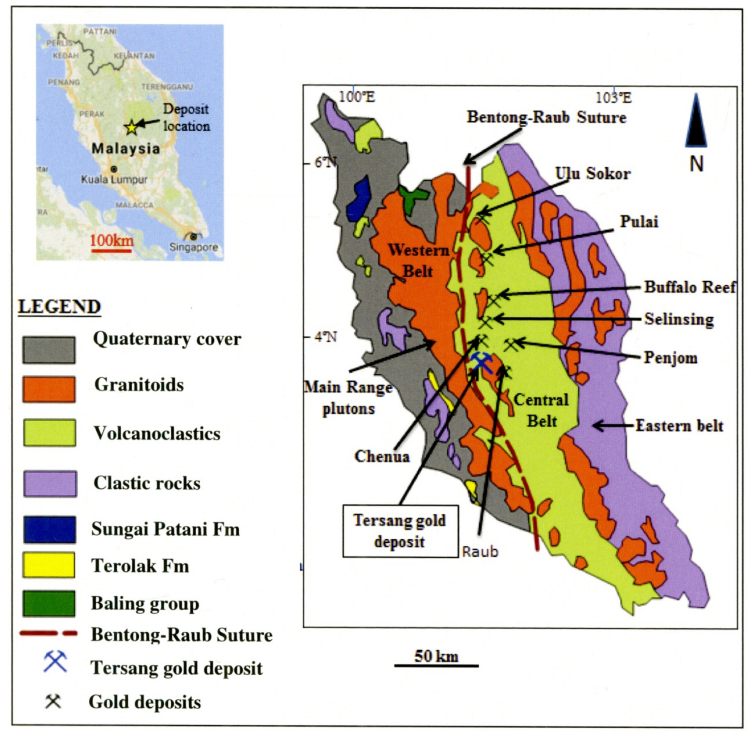
 DownLoad:
DownLoad: 